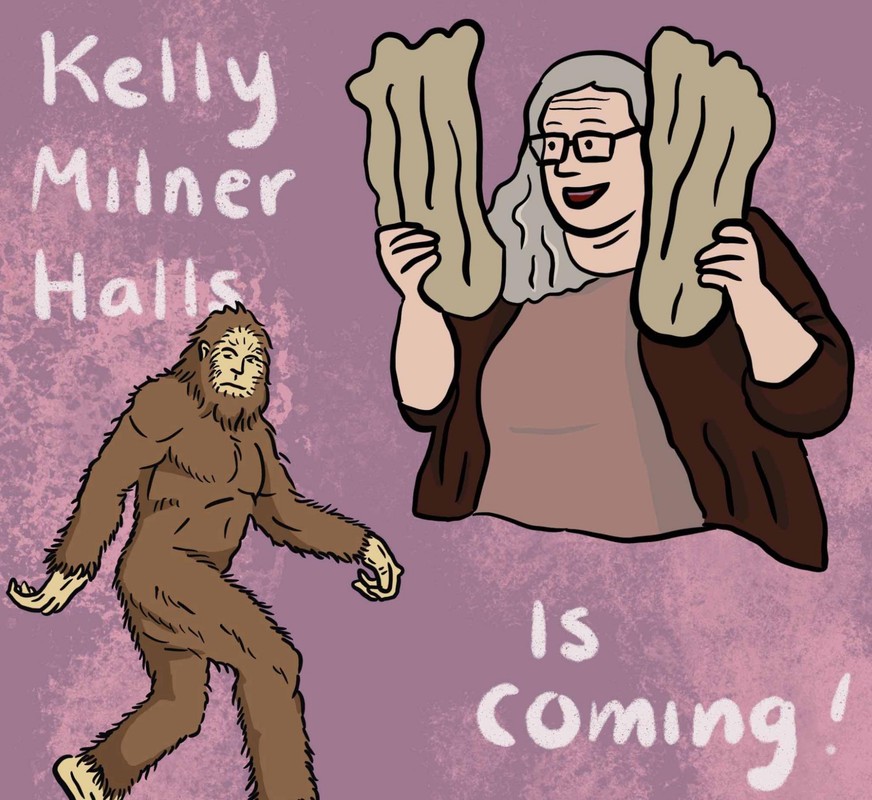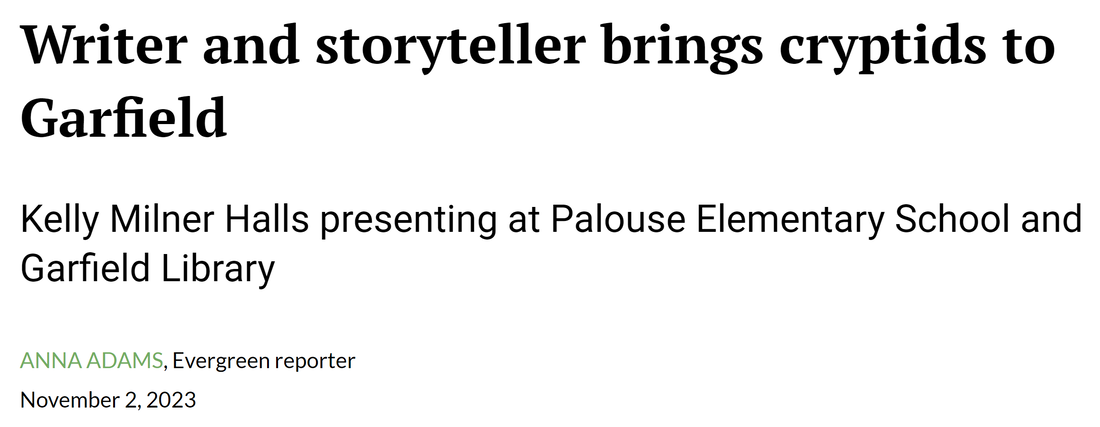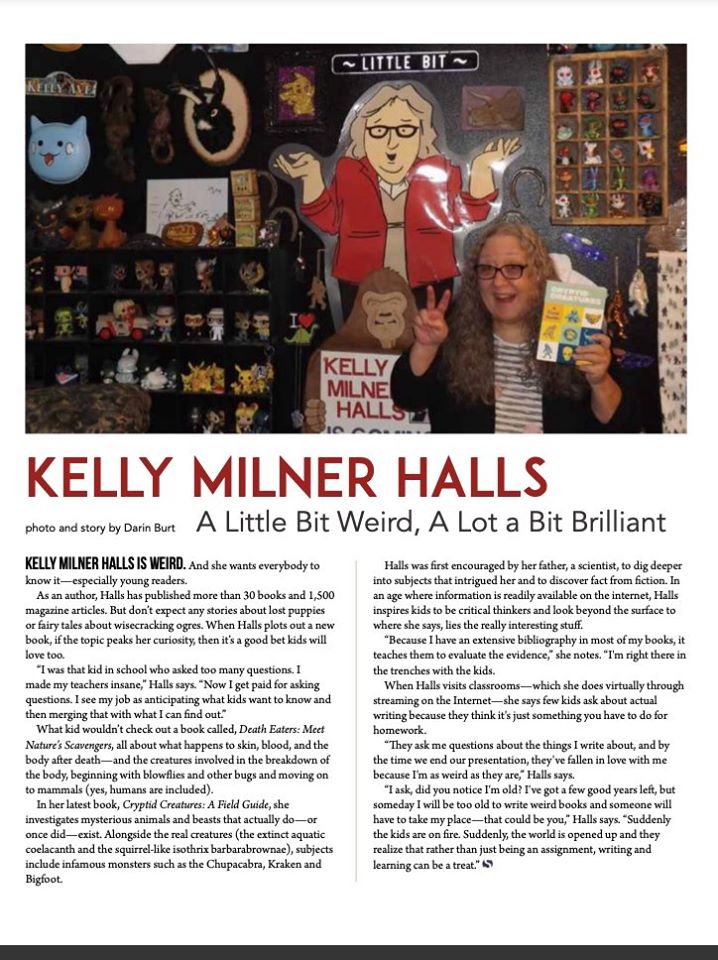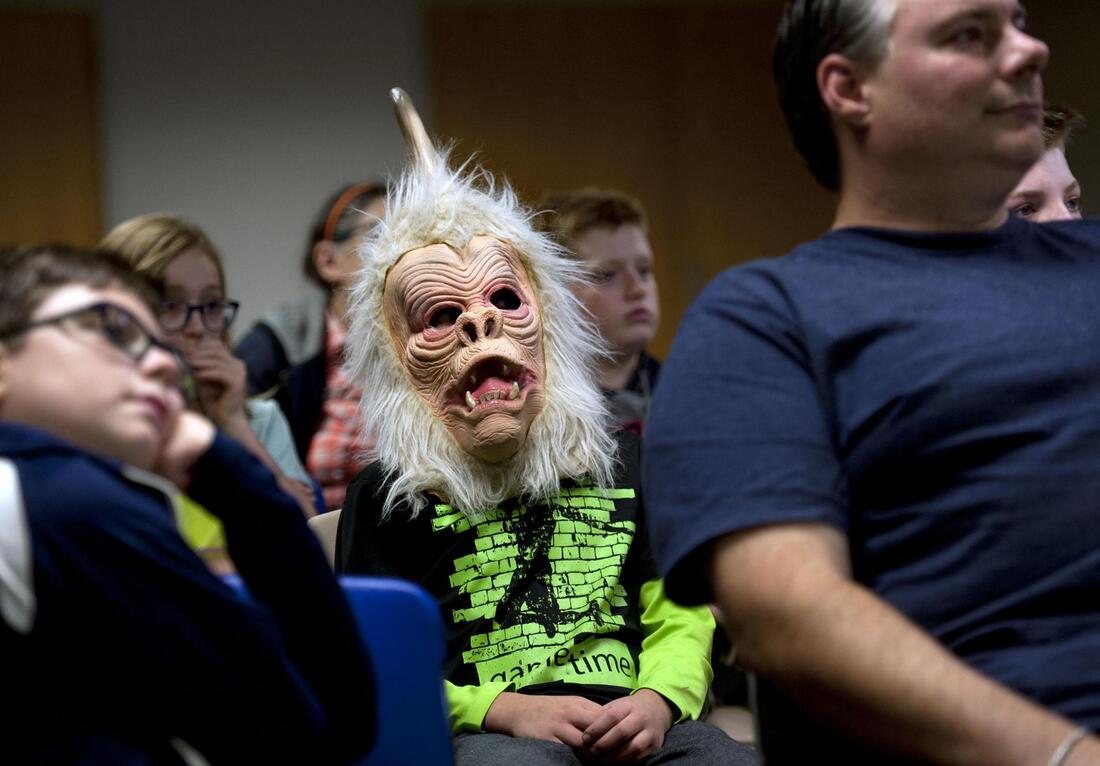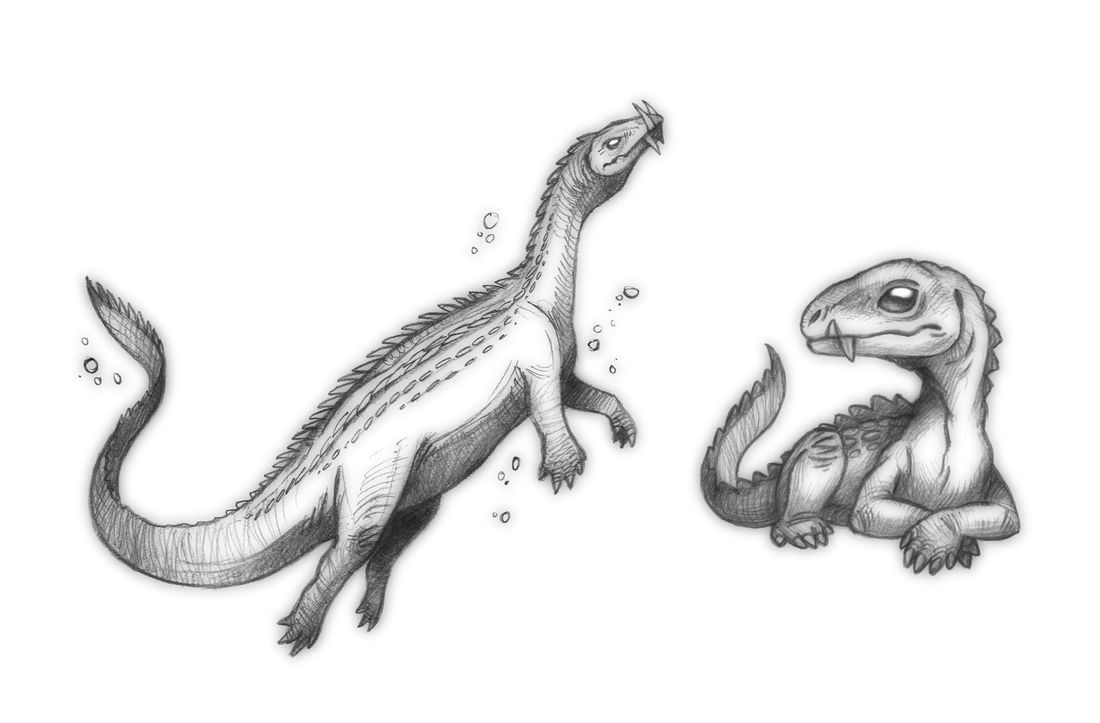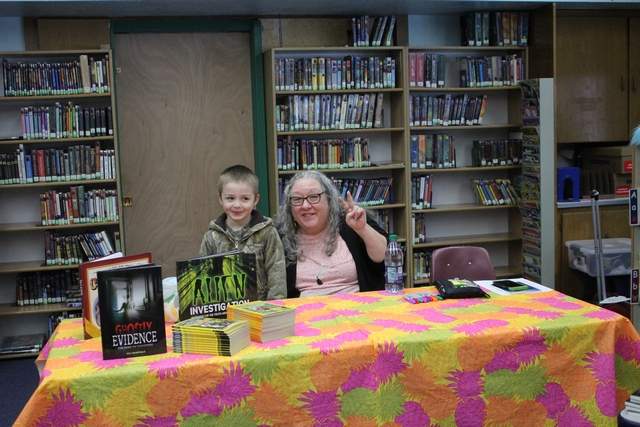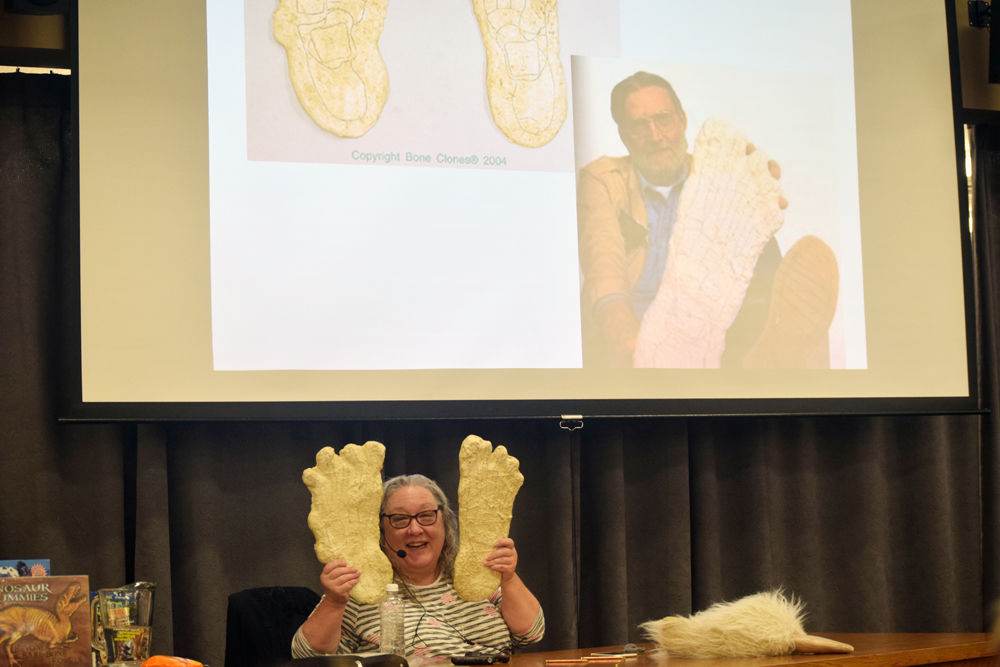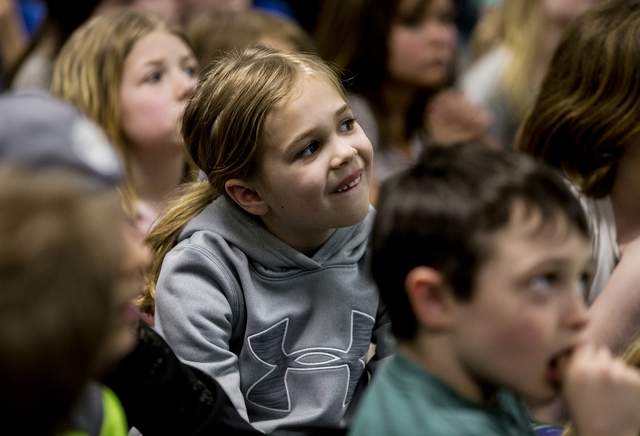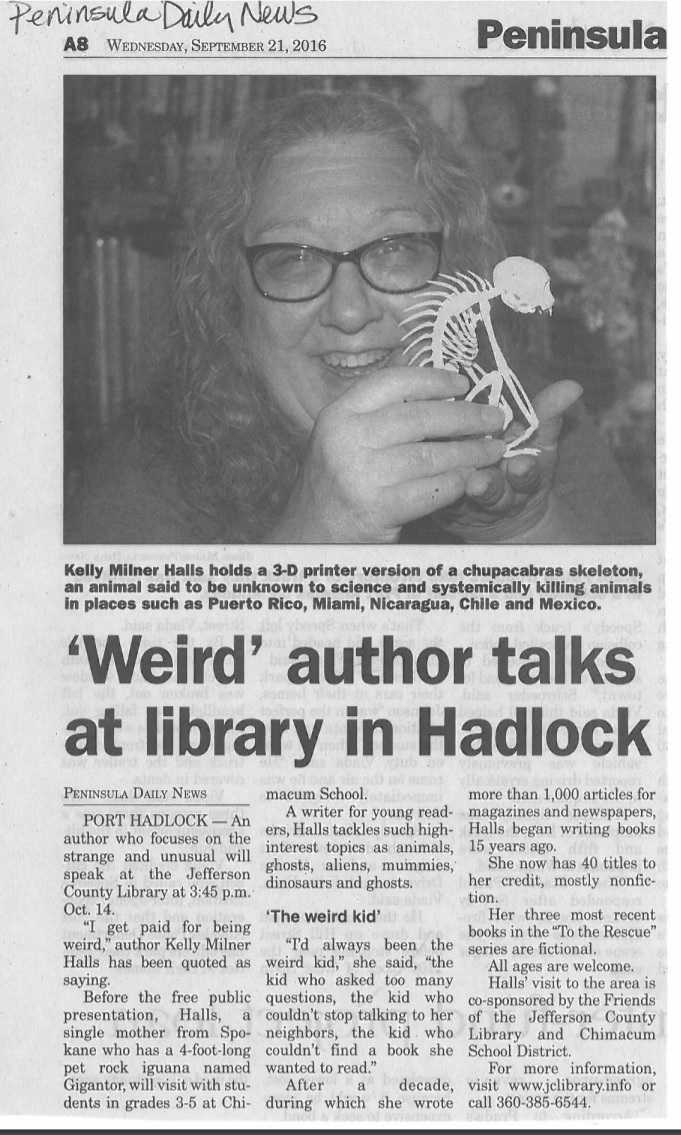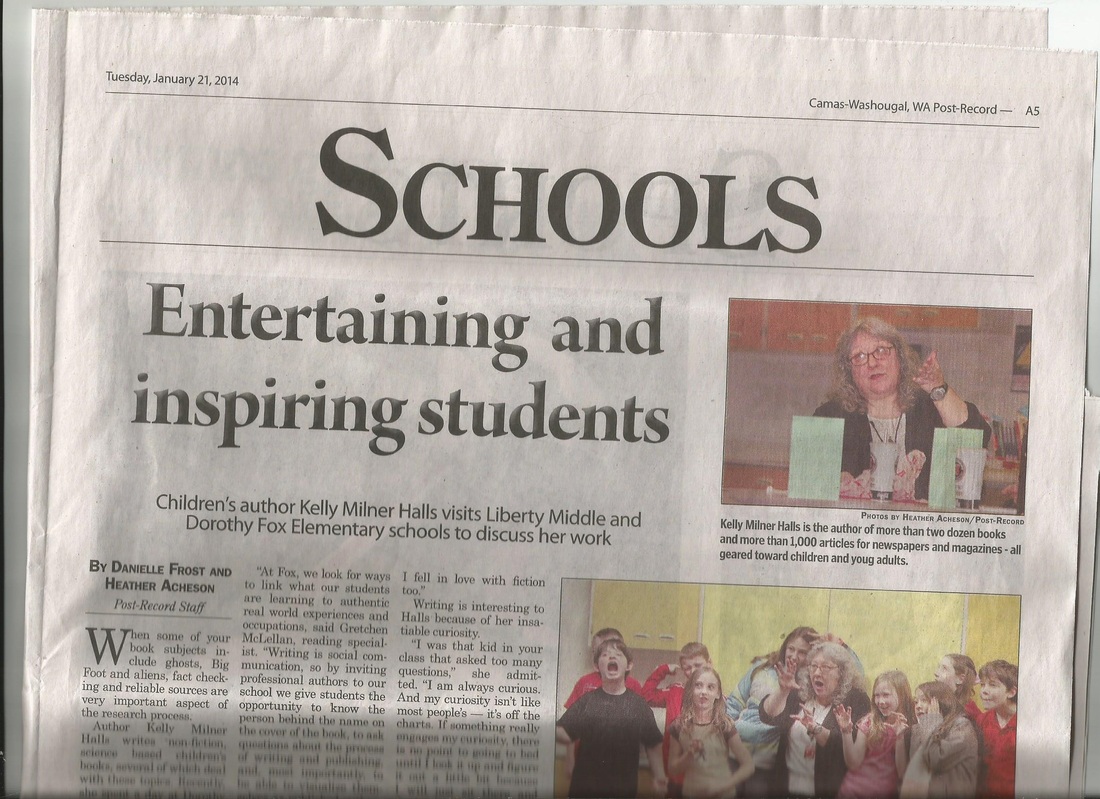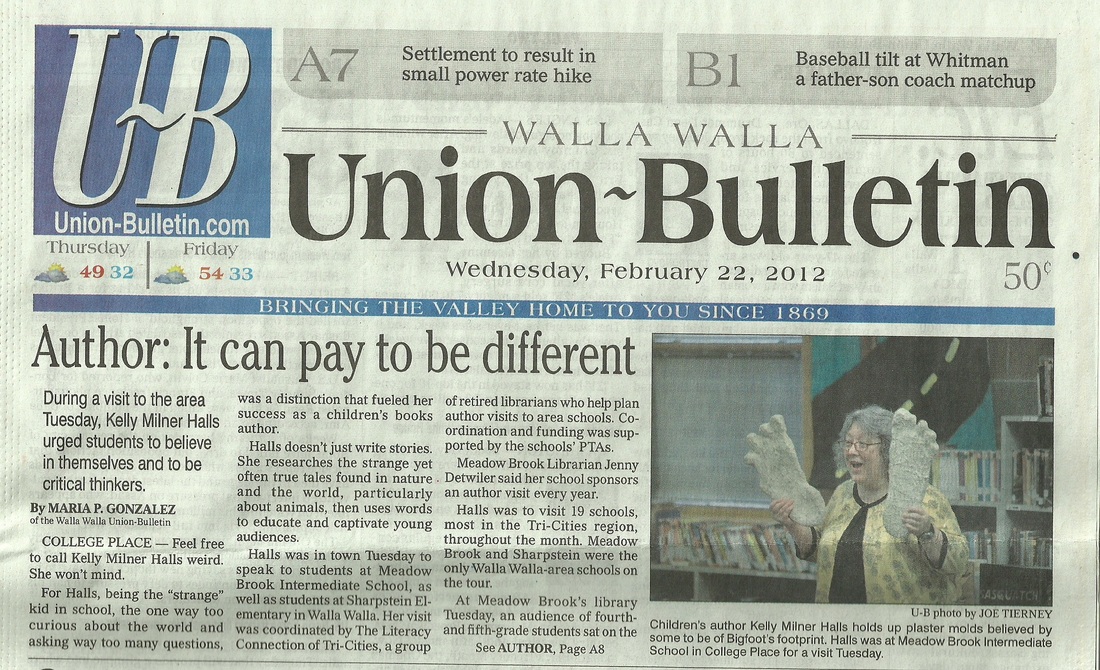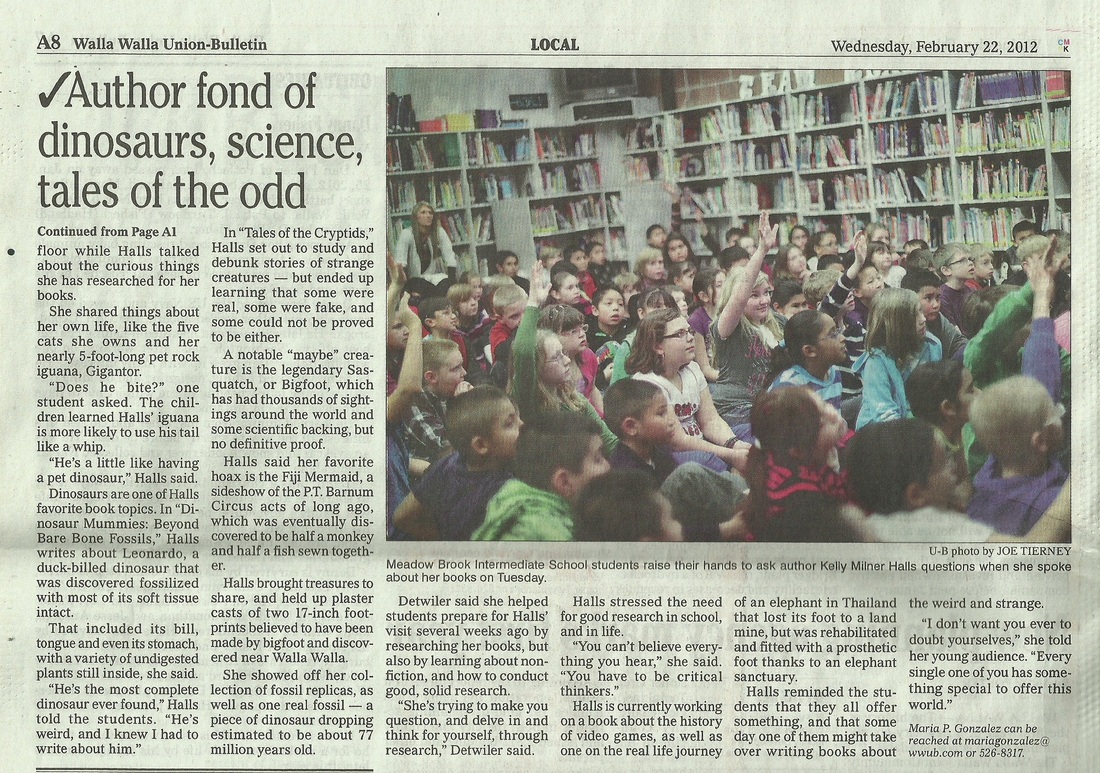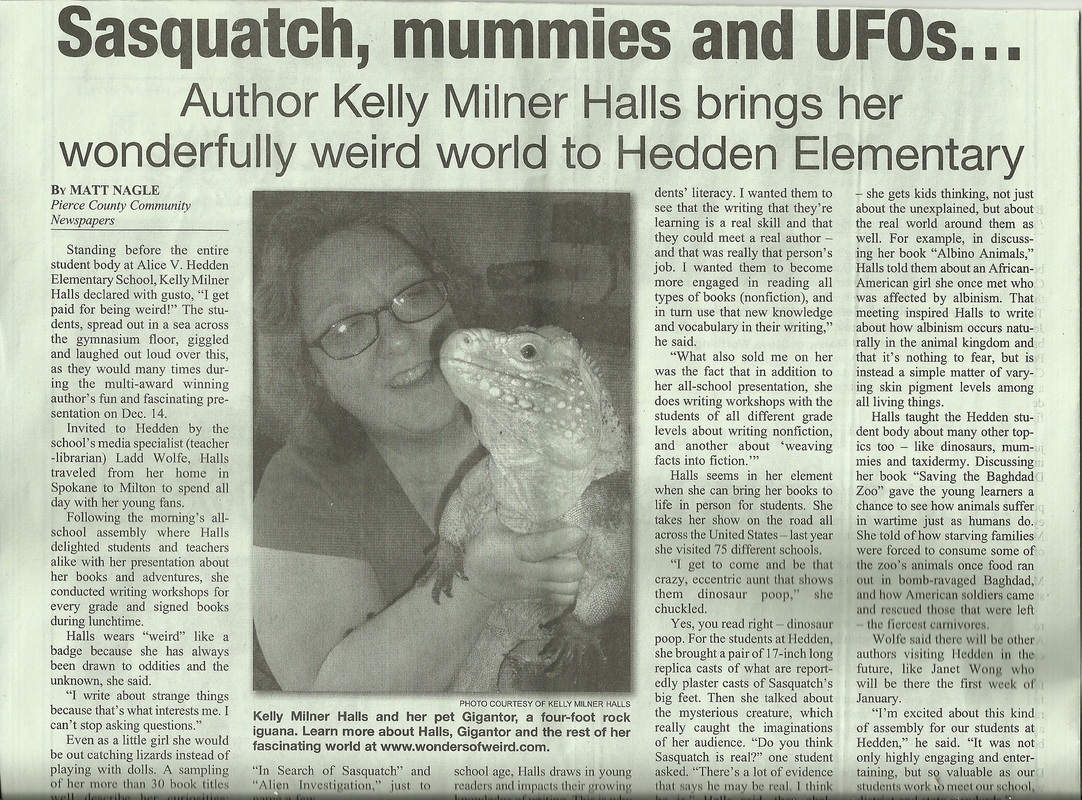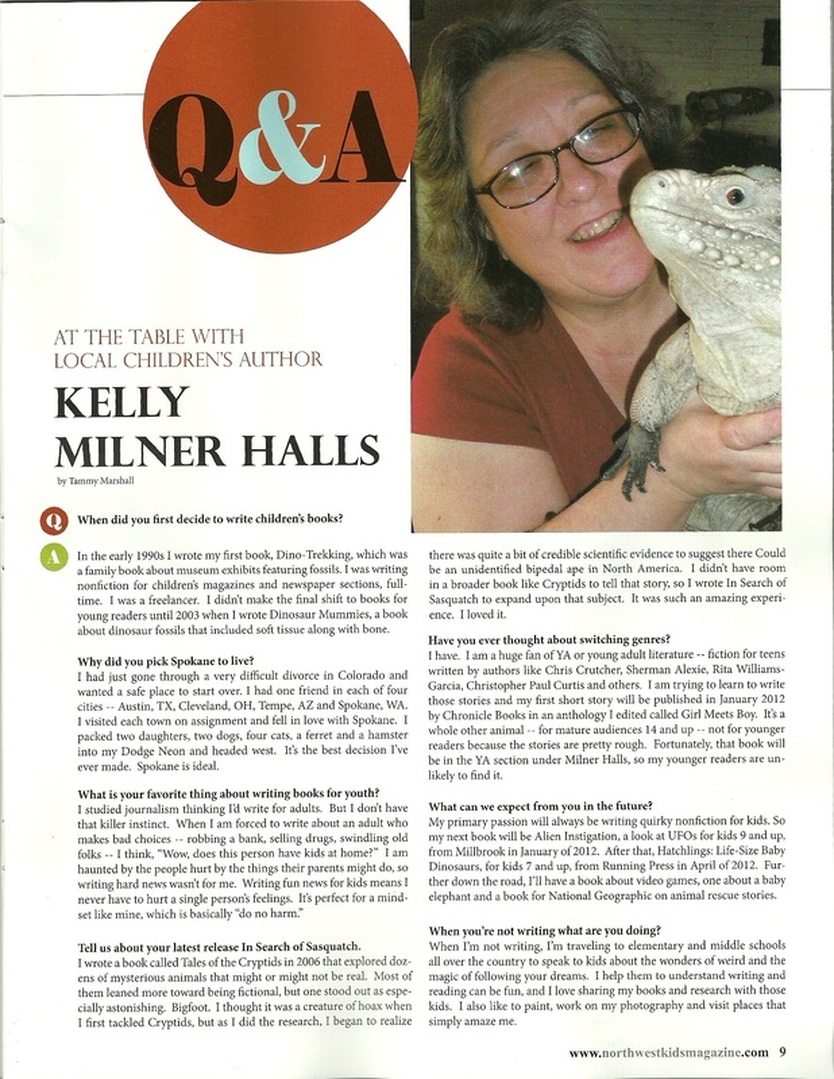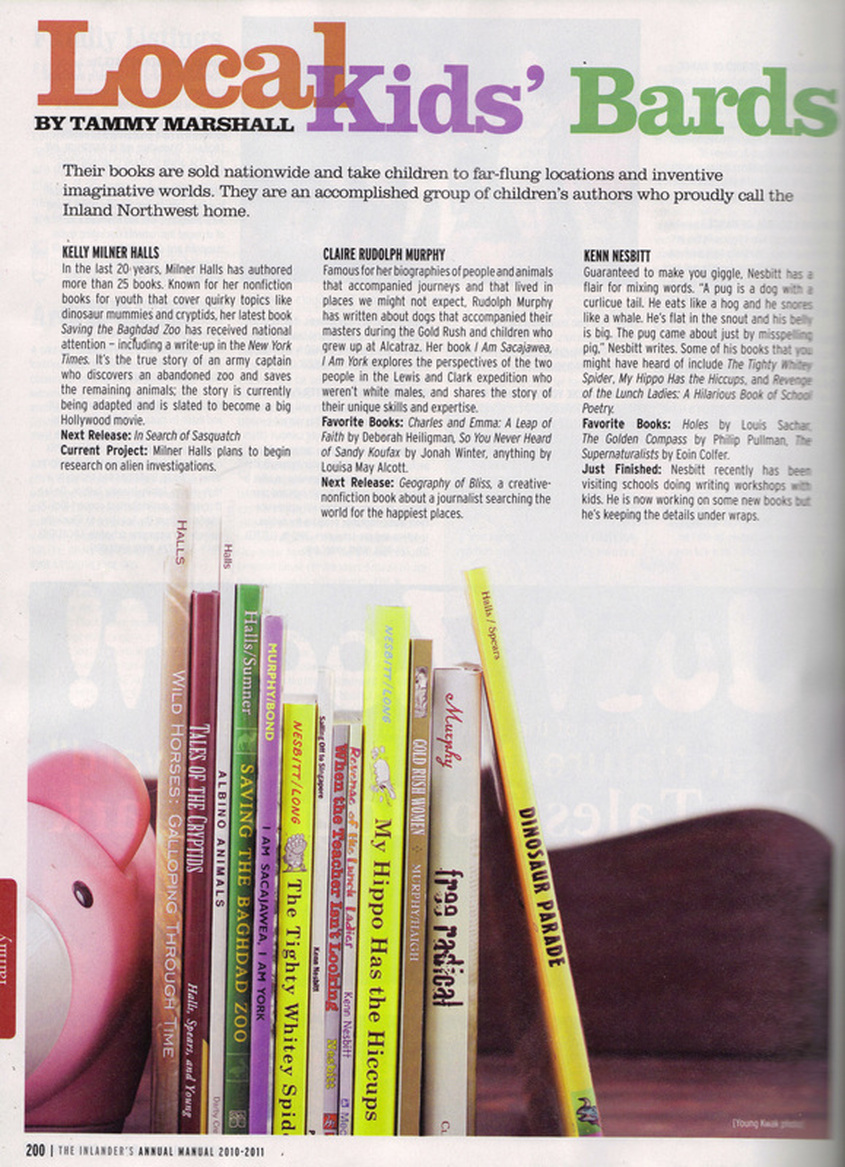I stopped by at "New day Northwest," in Seattle, WA
on King 5 on Friday, September 27, 2019. Check it out!
A local author is visiting Garfield’s library and elementary school Friday to do presentations on Bigfoot and cryptozoology.
Children’s book author Kelly Milner Halls is based in Spokane. She mostly writes nonfiction books and has extensively researched cryptozoology and Bigfoot.
Halls will be presenting on cryptozoology, the study of mysterious animals, at 12:10 p.m. at Palouse Elementary School in Garfield. At 3:30 p.m., she will present on Bigfoot at Garfield Library.
The presentations are 45 minutes long, Garfield Library librarian Sarah Anderson said. After presenting, Halls has casts of Bigfoot footprints and other interesting items for the children to see.
Anderson said Halls was recommended to her because she had been to the Colfax Library branch of the Whitman County Rural Library District.
“I ended up doing a Bigfoot theme because I am also doing trail tales in Elberton and that is all about Bigfoot,” Anderson said. “Because Kelly does cryptids and stuff I thought it would be fun to tie it in.”
Halls said she became interested in researching and writing about Bigfoot when she realized there were no children’s books that supported the belief in Bigfoot; they only portrayed the cryptid as a myth.
About 20 years ago, Halls decided to extensively research Bigfoot by interviewing scientists, eyewitnesses and researchers. Although she said she has not come to a conclusion on whether or not Bigfoot is real, she writes about what she learns so people can come to their own conclusions.
“It ended up being a super interesting thing and the kids love it,” Halls said.
Halls said she does not want children to be scared of mysteries that cannot be proven; rather, her presentations exist so children can keep an open mind on these topics.
Children’s book author Kelly Milner Halls is based in Spokane. She mostly writes nonfiction books and has extensively researched cryptozoology and Bigfoot.
Halls will be presenting on cryptozoology, the study of mysterious animals, at 12:10 p.m. at Palouse Elementary School in Garfield. At 3:30 p.m., she will present on Bigfoot at Garfield Library.
The presentations are 45 minutes long, Garfield Library librarian Sarah Anderson said. After presenting, Halls has casts of Bigfoot footprints and other interesting items for the children to see.
Anderson said Halls was recommended to her because she had been to the Colfax Library branch of the Whitman County Rural Library District.
“I ended up doing a Bigfoot theme because I am also doing trail tales in Elberton and that is all about Bigfoot,” Anderson said. “Because Kelly does cryptids and stuff I thought it would be fun to tie it in.”
Halls said she became interested in researching and writing about Bigfoot when she realized there were no children’s books that supported the belief in Bigfoot; they only portrayed the cryptid as a myth.
About 20 years ago, Halls decided to extensively research Bigfoot by interviewing scientists, eyewitnesses and researchers. Although she said she has not come to a conclusion on whether or not Bigfoot is real, she writes about what she learns so people can come to their own conclusions.
“It ended up being a super interesting thing and the kids love it,” Halls said.
Halls said she does not want children to be scared of mysteries that cannot be proven; rather, her presentations exist so children can keep an open mind on these topics.
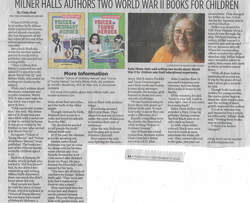
Creatures and curiosity:
Cryptid Trivia caps lively session at library
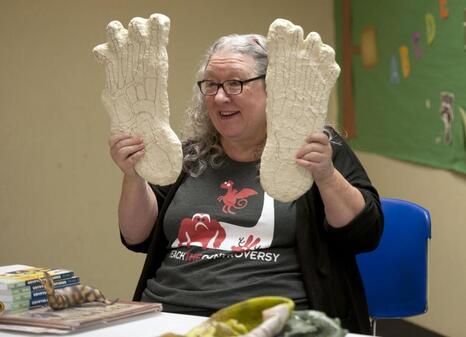
Thu., Oct. 31, 2019
By Cindy Hval [email protected]
A rumored sighting of Bigfoot at the Spokane Valley Library last week has been confirmed. Sasquatch was there. So was the Creature from the Black Lagoon and Gorn, from “Star Trek” fame.
Admittedly, Sasquatch was in a can, and the Creature and Gorn were latex masks; but the crowd of children and adults gathered for Kelly Milner Halls’ presentation about cryptid creatures was ready to believe in the reality of mythical monsters. Or at least to consider the possibility that creatures like the Loch Ness Monster might exist.
When a colleague mentioned Milner Halls had a new book out this fall, Spokane County Library District Librarian Alison Johnson knew she wanted to book a program featuring the prolific author.
“I knew the kids would be fascinated,” Johnson said. “This time of year kids are geared toward the fantastical.”
It doesn’t get more fantastical than “Cryptid Creatures: A Field Guide,” Milner Halls’ latest book.
“My books explain things that I was curious about as a kid, or things I was scared of,” Milner Halls said. “I watched all those Bigfoot movies with my dad, and when I asked him if they were real, he’d say, ‘I don’t know, we need more information, more evidence to be sure.’ ”
That sparked a curiosity in her that still burns bright, and she enjoys creating that same excitement and thirst for information in children during her presentations at schools and libraries.
“Kids are my kindred, my tribe,” she said.
She’s written about all kinds of mysterious things like ghosts, mummies and Bigfoot. She said the most popular section of her 2006 book, “Tales of the Cryptids,” was the dictionary in the back of the book.
And that’s what spawned the field guide featuring 50 mysterious creatures that may, or may not, be real. Each cryptid is highlighted with three illustrations.
At the Spokane Valley Library, she regaled kids with tales of “Champ,” America’s Loch Ness Monster, Chupacabra and the Lizard Man of Scape Ore Swamp.
Milner Halls works hard to find credible sources but wants her readers to reach their own conclusions.
“Lots of animals could turn out to be real, or they could be fake,” she told the crowd. “I give you the evidence and let you decide.”
Her presentation concluded with a game of Cryptid Trivia, and kids were eager to win prizes, including Canned Sasquatch and a copy of “Cryptid Creatures.”
Lively interaction is just what library organizers hoped for.
“It’s a great way to encourage kids to think critically, and it promotes discussion with family and friends,” Johnson. said “It gets them to ask questions.”
As for Milner Halls’ own thoughts about Bigfoot?
“It’s just my opinion, but I’m 80% sure he’s out there,” she said.
Santiago McAllister, 7, wasn’t convinced.
“I don’t think Bigfoot is real,” he said.
His brother, Isaac McAllister, also 7, said he learned “Bigfoot has really big feet.”
Lexi Dees, 10, was excited to be a Cryptid Trivia prize winner.
“My dad’s nickname is Sasquatch because he’s superhairy,” she said.
In addition to helping hone children’s critical thinking skills, Milner Halls hopes they’ll pursue their own mysteries.
“I’ll be 62 on my next birthday,” she told the group. “Someday, I’ll be too old to write weird books and you could take my place.”
Parker Spencer, 14, is on it.
He said he’s read all of Milner Halls’ books “except the ghost one,” and when he studied Greek mythology, it was the creatures, not the heroes, that captivated him.
“I’m starting to make a cryptid creatures guidebook,” he said. “I started with Ireland, Scotland and Japan, and I’m thinking about which country to do next. I want to write about as many as I can.”
By Cindy Hval [email protected]
A rumored sighting of Bigfoot at the Spokane Valley Library last week has been confirmed. Sasquatch was there. So was the Creature from the Black Lagoon and Gorn, from “Star Trek” fame.
Admittedly, Sasquatch was in a can, and the Creature and Gorn were latex masks; but the crowd of children and adults gathered for Kelly Milner Halls’ presentation about cryptid creatures was ready to believe in the reality of mythical monsters. Or at least to consider the possibility that creatures like the Loch Ness Monster might exist.
When a colleague mentioned Milner Halls had a new book out this fall, Spokane County Library District Librarian Alison Johnson knew she wanted to book a program featuring the prolific author.
“I knew the kids would be fascinated,” Johnson said. “This time of year kids are geared toward the fantastical.”
It doesn’t get more fantastical than “Cryptid Creatures: A Field Guide,” Milner Halls’ latest book.
“My books explain things that I was curious about as a kid, or things I was scared of,” Milner Halls said. “I watched all those Bigfoot movies with my dad, and when I asked him if they were real, he’d say, ‘I don’t know, we need more information, more evidence to be sure.’ ”
That sparked a curiosity in her that still burns bright, and she enjoys creating that same excitement and thirst for information in children during her presentations at schools and libraries.
“Kids are my kindred, my tribe,” she said.
She’s written about all kinds of mysterious things like ghosts, mummies and Bigfoot. She said the most popular section of her 2006 book, “Tales of the Cryptids,” was the dictionary in the back of the book.
And that’s what spawned the field guide featuring 50 mysterious creatures that may, or may not, be real. Each cryptid is highlighted with three illustrations.
At the Spokane Valley Library, she regaled kids with tales of “Champ,” America’s Loch Ness Monster, Chupacabra and the Lizard Man of Scape Ore Swamp.
Milner Halls works hard to find credible sources but wants her readers to reach their own conclusions.
“Lots of animals could turn out to be real, or they could be fake,” she told the crowd. “I give you the evidence and let you decide.”
Her presentation concluded with a game of Cryptid Trivia, and kids were eager to win prizes, including Canned Sasquatch and a copy of “Cryptid Creatures.”
Lively interaction is just what library organizers hoped for.
“It’s a great way to encourage kids to think critically, and it promotes discussion with family and friends,” Johnson. said “It gets them to ask questions.”
As for Milner Halls’ own thoughts about Bigfoot?
“It’s just my opinion, but I’m 80% sure he’s out there,” she said.
Santiago McAllister, 7, wasn’t convinced.
“I don’t think Bigfoot is real,” he said.
His brother, Isaac McAllister, also 7, said he learned “Bigfoot has really big feet.”
Lexi Dees, 10, was excited to be a Cryptid Trivia prize winner.
“My dad’s nickname is Sasquatch because he’s superhairy,” she said.
In addition to helping hone children’s critical thinking skills, Milner Halls hopes they’ll pursue their own mysteries.
“I’ll be 62 on my next birthday,” she told the group. “Someday, I’ll be too old to write weird books and you could take my place.”
Parker Spencer, 14, is on it.
He said he’s read all of Milner Halls’ books “except the ghost one,” and when he studied Greek mythology, it was the creatures, not the heroes, that captivated him.
“I’m starting to make a cryptid creatures guidebook,” he said. “I started with Ireland, Scotland and Japan, and I’m thinking about which country to do next. I want to write about as many as I can.”
Cryptid Creatures: "The Feel Good Field Guide of 2019"
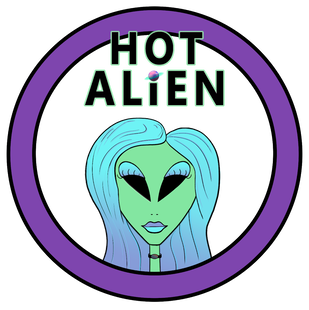
September 24, 2019
Kelly Milner Halls and Rick Spears go way back. Not as far as the legends featured in their work, but far enough to have worked on eight projects together, including their latest book Cryptid Creatures, which just hit the real (and cyber) shelves today.
Cryptid Creatures is a field guide featuring 50 mythical animals (AKA cryptids). Each entry presents a description of the creature, its history, and evidence suggesting that it exists—which often includes colorful accounts told in newspaper articles. Every cryptid also gets a “reality rating” represented by a scale of 1-6 stars. One star means the cryptid has been confirmed as a hoax, while six stars means the once-mythical creature has been proven real.
Cryptids covered in the book range from well-known beasts like Bigfoot and the Loch Ness Monster, to the more obscure—such as the Iliamna Lake Monster of Alaska (which has the head of a wolf and body of an orca whale) and the Con Rit (a centipede purported to be larger than any known shark).
The creature illustrations depict the beasts in two stages of their lives, both as full-grown monster legends, and also as baby beasts—when the creatures were nothing but whispered tales around the campfire.
Halls is a prolific children’s book author and freelance writer, and Spears is an illustrator and sculptor with a focus on animals, science, and natural history.
I talked to both about the artistic inspiration behind Cryptid Creatures, why cryptids should be examined like real animals, and how they bonded over the bizarre in the first place.
So how did you two meet?
K: Well, I was working on this book called Dino-Trekking in 1996, and I was looking for a paleontology expert from Georgia State to interview. And some guy in Georgia—I can’t remember who it was—said, “You really shouldn’t be talking to me, you should be talking to Rick Spears. He’s everything dinosaur.” And I said how do I get a hold of him?
R: He made it seem like I was a crackpot or something.
K: Well, so was I, so it worked out. Rick was just the best; he and I talked and he asked. “Who is illustrating the book?” And I said we don’t have a budget for illustrating, and he said, “Well, I’ll do it for free.” And I said, ‘“This guy is the best guy ever!”
How can you afford to do a project like that for free?
R: I have this philosophy that there are some things that should exist no matter the cost or lack of cost, so I’ve been known to work for free for good ideas if people have them. And you know, I can do it. I have a roof over my head, I make enough money at my regular job, and if I can help somebody else out, I’m gonna do it.
K: He also has mad skills.
R: Plus I got a few copies of the book, which was kinda cool because it was the first real book I worked on.
K: He also got seven book deals off of that later, so that’s not too bad. Together, we’ve both worked on Dino-Trekking, Dinosaur Mummies, Tales of the Cryptids, Dinosaur Parade, Mysteries of the Mummy Kids, In Search of Sasquatch, Alien Investigation…
R: And then of course, Cryptid Creatures—the feel good field guide of 2019.
Kelly, how long have you been writing?
K: I studied journalism in college and thought I was going to be an investigative reporter. Then I realized I didn’t have the mean streak to be that tough, so I decided to write for kids. I started freelancing in about 1987 and I freelanced for a long time. In the children’s market, a lot of magazines buy all rights, and all my writing friends were saying, “You’re supporting the corporate machine! You need to start writing books so you get a royalty.” So I tried that and have been doing that ever since. I freelance every once in awhile if there’s something interesting I want to cover.
Rick, how long have you been artisting?
R: Since I was a kid, when my dad used to bring home old copy paper and I’d draw on the back of it. I’ve never known a time when I wasn’t drawing. But professionally, I got a degree in graphic design from the University of Georgia with a focus on illustration, and I work non-stop.
K: Rick can take something speculative like aliens or a sasquatch and turn it into something that feels possible. A lot of the illustrators make fun of the cryptid material; you can see skepticism in their artwork. But when Rick takes on a topic he endows it with something living—and the kids love it too.
R: Well, yeah. When I’m drawing cryptids, I think of them as animals, living organisms. They follow the same rules of physics we do, and do what we do: they eat, they sleep, walk around.
K: I can also trust Rick to go to scale. Other illustrators, they have fun with drawing cryptids, but they don’t check the science. Even though some of my books involve the question of whether something is real or not real, when I do a book I want to find the best information possible, and I want somebody to work with who is going to be on the same page and have respect for the material too. When I was putting this book together, I really wanted to go for the gold. If confronted by someone who might say, “Where’d you get this information from? Wikipedia?” I wanted to be able to point to the bibliography and show I did my job. And almost every single cryptid—I think there were two where I couldn’t find a solid newspaper article or magazine—has a substantial source behind it.
Rick, do you have any artistic influences?
R: I love the work of Charles Knight, illustrator and painter of prehistoric things from the late 1800s. He breathed life into things. He would go out and observe animals in zoos and then apply the characteristics to the prehistoric monsters he drew. Well, people would call them monsters, but they were prehistoric animals. Once I was reading an encyclopedia and there was a picture of one of his paintings and I thought it was a photograph.
Do you believe cryptids are real?
K: Do I believe they’re all real? No. I think in some cases people had too much party punch. But you know, they reported to the newspaper that they saw it. So if it was in the Boston Globe, then it’s in my book. When it comes to writing children’s books, kids don’t want you to tell them if something is real or not; they want you to give them the evidence, then let them decide. Because God knows, young readers aren’t empowered in any way, shape or form. For the most part, they’re completely controlled. Giving them choices isn’t a bad thing, and it’s a good exercise. I mean, I believe in the possibility of Bigfoot at this point—and I didn’t believe that 12 years ago when I started all this.
Over and over again I’ve heard these stories from people who didn’t care about seeing Bigfoot, didn’t want to see him, and they’d end up seeing him! And they’re reliable people. I mean, you hear from some of the tin foil hat guys, but once you hear enough people who are credible you start to think… this isn’t what I thought it was gonna be.
I interviewed this truck driver who went on a Bigfoot hunting thing, and he only went to play with his new night vision goggles and he was walking back to his truck and heard a noise, and he turned around and it was a bigfoot, and said he wet his pants. And I thought, “What kind of burly truck driver would tell a woman that he wet his pants when he saw Bigfoot?” He said it was so big and so scary and he didn’t know what to do, and he was glad when the bigfoot ran away.
That truck driver was one of the most amazing interviews I’ve ever had, and I think he’s legit. But who knows? I could be wrong.
What about you, Rick?
R: Oh me? I’m real.
K: Rick…
R: Okay, okay. So I think people are seeing something, but if it’s really a bigfoot, we don’t know because we weren’t there. A lot of times there’s no evidence, there’s only word of mouth. There’s times I think there’s a chance that they’re real… and then I look at the evidence and I think it’s all faked—including the Patterson/Gimlin film. I think the worst thing that happened to the PG film, in terms of proving Bigfoot’s validity, is when people stabilized the footage. There are wrinkles in the suit, but people explain it away in a dozen different ways. Basically, when it comes to the question of whether I think Sasquatch is real, I’m not saying no, but I’m not saying yes.
What inspired the baby cryptids featured in the book?
R: Well, when a mommy cryptid and daddy cryptid love each other very much…
K: She’s not asking how a baby is made, pinhead!
R: Oh, right. Sure, okay… We had talked about doing a book on baby cryptids.
K: Yeah, still a work in progress.
R: I looked at this opportunity and thought about what my options were to fill page space. Sure, I could have drawn yet another bigfoot walking to the left or a bigfoot walking to the right, or I could draw another footprint. But instead, I chose to draw babies and young cryptids, because it kept the illustrations fresh.
My favorite is the one of the baby Yeti rolling a snowball. It was inspired by a National Geographic photo of this Japanese monkey carrying a snowball. So some of the cryptids in the book are babies, some are kid versions. The Beast of Busco [a giant snapping turtle that could feed on deer] is an egg! Just a round egg. It was so much fun. My favorite part of the book was drawing the babies! I’ll also add that my least favorite part about drawing these creatures was figuring out what to do with the genitals. It’s always a thing when you draw animals. Like the mermaid, she’s got her arm just so, so you don’t see her breast. Some have their legs crossed and off the side. I mean, you probably don’t want to have a full-on view of Bigfoot… probably.
I loved the differences between the adults and the children. Like the New Jersey Devil looks so evil, and then you see the New Jersey Devil foal with its big eyes and sweet features. Thinking about these cryptids as children gives them a timeline, orients them into space, gets readers thinking of how they could have grown or come to be.
K: I know! They don’t start evil. They grow into it. I also love the skeletal features that he used.
R: I wanted to bring them down to Earth and make them real animals. Because you know, if they exist….
K: Then they exist completely.
R: Yeah. They had to start off as babies and had to have parents and would have bones in their heads.
How did you decide which cryptids to incorporate into the book and which ones to nix?
K: Rick made a lot of decisions about which ones to use. I’d send him a list and he’d say, “Agh! Don’t use that one! That one is terrible.” So I figured if he didn’t want to draw a specific cryptid then it wouldn’t be fun, so we’d skip it. But he had to draw some he wasn’t crazy about. What was that one you really didn’t like drawing, Rick?
R: The Pugwudgie! A little troll thing. Like an elf. Too magical and more fantasy-related.
K: For the most part, we steer away from from fantasy stuff. Like we would never put a unicorn in one of our books.
R: Or a vampire. Or a vampire unicorn.
K: Apart from the Chupacabra. He’s a vampire.
R: Oh, yeah. He’ll drink from a goat like it’s a juice box.
How did you decide which encounters and personal stories to include for each creature? It seems like you probably had a ton to choose from.
K: I wanted to go for the most credible source. I didn’t want to feature a sighting that some random person posted at bottom of blog, so I included anecdotes that came from reputable news sources. Part of the reasoning for this is that I want to get kids to source things themselves and engage their critical thinking process. I want them to think, ‘Well, maybe this is true. But I’m gonna look it up!’ When I give talks to kids, we discuss critical thinking. Like how did this dinosaur get sourced back to prehistoric times? How do I know what albino animals are? How do I know this dog saved someone from a railroad track? Those are great stories, but are they true stories? Critical thinking is how you tell the difference.
When it comes to Cryptid Creatures, are there any key takeaways for readers?
R: Well, what I want people to take away is the book—but pay for it first.
K: Yeah, totally.
R: I’d also like them to think of cryptids as real animals and think about the possibility of them existing on Earth.
Why should readers think of cryptids as real animals?
K: Because we’re discovering new animals every day. There are always new discoveries—it may or may not be a big sasquatch, but every person on the planet could go out into the wilderness and see something no one has seen before.
R: The African gorilla was once a cryptid. You just never know. All you have to do is find that one piece of evidence and a cryptid becomes a non-cryptid.
K: Also, these cryptids were real to the eye-witnesses who saw them. That counts.
This interview has been edited for length and clarity.
https://hotalien.com/cryptid-creatures-the-feel-good-field-guide-of-2019/
Featured in the writer magazine

EXPERT TIPS FOR SCHOOL AUTHOR VISITS
Connect to young readers with dynamic classroom visits.
By Melissa Hart, January 19, 2017
When Kelly Milner Halls arrived for a school visit, the librarian warned her about a quirky third grader who would be at every one of her six sessions that day. He had checked out only one book each week: Milner Halls’ Tales of the Cryptids: Mysterious Creatures That May or May Not Exist.
“He sat with me at lunch and got suddenly quiet,” says the author. “Then he said, ‘I never thought this day would come.’ I asked, ‘What day is that?’ and he said, ‘I never thought the day would come when I would meet someone like me.’ Those are the days when you know you’ve got a good life.”
School visits such as the dozens Milner Halls does allow authors who write for children to increase both readership and book sales. Best of all, writers have a chance to interact with – and learn from – their target audience. “My life is about curiosity,” Milner Halls says, “and we get to celebrate that curiosity together.”
Schools across the country pay for dynamic speakers to offer presentations to small and large groups. With thousands of authors eager to connect with their audiences, how can you ensure that your performance stands out as more thrilling than the Kidizoom Smartwatch DX?
Preparation is keyPicture book author Kim Norman runs a blog called Cool School Visits. When she receives contact information for a school’s event coordinator, she sends guides to her books with activities that teachers can do before or after her visit. She offers a poster that coordinators can download from her site and bookmarks for distribution. She also provides a video compilation of book-cover images and pictures of her Newfoundland dog for organizers to run as students assemble for her presentation.
“In advance of my visits,” she says, “I send coordinators a ‘scavenger hunt’ of my website for students to do before I come. It’s a fun little quiz about images and factoids that they can find on my site.”
Young adult author Maria E. Andreu notes that the more prepared the school is, the more successful the author’s visit will be. Before one of her events, administrators got a grant to buy copies of her book The Secret Side of Empty for English classes. “They prepped students by having them write questions ahead of time, planned a breakfast and reception and involved their school media team in an on-camera interview with me,” she says. “The kids were excited and engaged because they’d been so involved in the planning and execution of the event.”
Rock it in real time“Performing to a group of 300 students is like a Springsteen concert,” says David Biedrzycki, author and illustrator of the Ace Lacewing Bug Detective series. “You’ve got to rock it. Do something that no one else does. Be educational without appearing to be.”
Biedrzycki visits more than 60 schools a year and engages students with real-time creations of digital art on a laptop and graphic tablet. Milner Halls, whose topics are far-ranging, shows a PowerPoint presentation as she talks. She brings fossils and artifacts for students to touch. “I engage at least three of their senses, connecting with kids who learn in different ways,” she says.
Most authors agree that a successful presentation includes humor and gets students laughing. Some show funny pictures of their dogs. Others show funny photos of themselves as children. “Humor is the great icebreaker,” Biedrzycki says. “It gets kids on your side.”
Expert tips on school visits
(The Writer Magazine, January 2017)
Connect to young readers with dynamic classroom visits.
By Melissa Hart, January 19, 2017
When Kelly Milner Halls arrived for a school visit, the librarian warned her about a quirky third grader who would be at every one of her six sessions that day. He had checked out only one book each week: Milner Halls’ Tales of the Cryptids: Mysterious Creatures That May or May Not Exist.
“He sat with me at lunch and got suddenly quiet,” says the author. “Then he said, ‘I never thought this day would come.’ I asked, ‘What day is that?’ and he said, ‘I never thought the day would come when I would meet someone like me.’ Those are the days when you know you’ve got a good life.”
School visits such as the dozens Milner Halls does allow authors who write for children to increase both readership and book sales. Best of all, writers have a chance to interact with – and learn from – their target audience. “My life is about curiosity,” Milner Halls says, “and we get to celebrate that curiosity together.”
Schools across the country pay for dynamic speakers to offer presentations to small and large groups. With thousands of authors eager to connect with their audiences, how can you ensure that your performance stands out as more thrilling than the Kidizoom Smartwatch DX?
Preparation is keyPicture book author Kim Norman runs a blog called Cool School Visits. When she receives contact information for a school’s event coordinator, she sends guides to her books with activities that teachers can do before or after her visit. She offers a poster that coordinators can download from her site and bookmarks for distribution. She also provides a video compilation of book-cover images and pictures of her Newfoundland dog for organizers to run as students assemble for her presentation.
“In advance of my visits,” she says, “I send coordinators a ‘scavenger hunt’ of my website for students to do before I come. It’s a fun little quiz about images and factoids that they can find on my site.”
Young adult author Maria E. Andreu notes that the more prepared the school is, the more successful the author’s visit will be. Before one of her events, administrators got a grant to buy copies of her book The Secret Side of Empty for English classes. “They prepped students by having them write questions ahead of time, planned a breakfast and reception and involved their school media team in an on-camera interview with me,” she says. “The kids were excited and engaged because they’d been so involved in the planning and execution of the event.”
Rock it in real time“Performing to a group of 300 students is like a Springsteen concert,” says David Biedrzycki, author and illustrator of the Ace Lacewing Bug Detective series. “You’ve got to rock it. Do something that no one else does. Be educational without appearing to be.”
Biedrzycki visits more than 60 schools a year and engages students with real-time creations of digital art on a laptop and graphic tablet. Milner Halls, whose topics are far-ranging, shows a PowerPoint presentation as she talks. She brings fossils and artifacts for students to touch. “I engage at least three of their senses, connecting with kids who learn in different ways,” she says.
Most authors agree that a successful presentation includes humor and gets students laughing. Some show funny pictures of their dogs. Others show funny photos of themselves as children. “Humor is the great icebreaker,” Biedrzycki says. “It gets kids on your side.”
Expert tips on school visits
- “Encourage teachers to read a chapter or two of one of your books aloud to the class. Share book trailers in advance. These fun, short videos are an easy way to hook the kids’ interest in books and in the author.” —Julie Berry, The Scandalous Sisterhood of Prickwillow Place
- “Discussion guides are great, especially if they’re aligned to the Common Core.” —Maria E. Andreu,The Secret Side of Empty
- “Preschoolers have very short attention spans, so my best word of advice is to gather in a classroom setting, rather than an assembly, and to keep your story sessions short – 20 minutes at the most.” —Laura Sassi, Goodnight Manger and Goodnight Arc
- “Because many of my books have to do with sports, the school has the kids wear their favorite sports jersey on the day of my visit. It adds to the excitement and increases engagement from the students. —Brad Herzog, Count on Me Sports series
(The Writer Magazine, January 2017)
Well known author visits local kids
February 1, 2018
By Tanna Yeoumans, Staff Writer
BONNERS FERRY — The students of Valley View Elementary School and it’s staff welcomed the renowned author of children’s books and magazine articles, Kelly Milner Halls, on Thursday, Jan. 25, after having to reschedule from Wednesday’s school cancellation due to the winter weather.
“I am a children’s writer specializing in all things weird and wonderful and the critical thinking skills necessary to evaluate the evidence,” states Halls’ website. “My school visits explore those quirky topics and reliable research skills. My goal is to empower kids and to celebrate what makes us all unique.”
Halls lives in Spokane, Wash., and through her writing and presentations, she has brought children both local and far away the idea to ask questions, and seek the answers.
During her presentation, Halls gave the children an idea. The idea was to question, and to seek the answers, no matter how vague the clues may be.
According to Halls, the most interesting stories that she has written are the Bigfoot stories.
“Bigfoot just blew me away,” exclaimed Halls. “The more research I did, the more I thought hey, there is evidence that it is real. More people have bigfoot stories here than don’t.”
Halls chose to write according to how she sees the world. She formulates questions, and proceeds to find the answers.
“Who doesn’t want to research things that may or may not be real? That sense of what is the evidence? When I wrote Tales of the Cryptids, the one that started that interest, I thought that I was going to prove they were all fake, that was my plan, but it turned out that I could not find any definitive information,” said Halls. “If I couldn’t prove it was fake, I didn’t say it was fake, because that is as big of a lie as to say it was real. So, I left the evidence as to the for and against, and allowed them to decide.”
During her presentation, Halls showed the younger classes molds of Bigfoots footprint, and allowed them to decide which was fake, and which could be real. One print was just like a human foot and one was more deformed with bulges coming out of the side. She questioned the class asking if someone would make a fake print that had a deformity, which opened the discussion about deciphering between real and fake evidence. Halls concluded the presentation challenging the kids to ask a question, find evidence, and in the end find the answer.
Halls wrote a couple of books under the National Geographic logo, each three stories in one, and both about animal rescue stories. She has herself adopted rescue animals, and showcases them in her presentation to the children. She used a Powerpoint presentation complete with photos to show students not only how adopting a pet is beneficial, but how adopting her animals have affected her personally, showcasing the about four foot iguana, among her other adopted pets including cats and dogs.
Halls wanted to produce books that were affordable for the children when she did school visits. There are two ways to produce books — one is work for hire, which gives the author a one-time payment and the books sold through that company are more inexpensive to the buyer. The second way is royalty books, which enables the author to make an amount for each book sold, but tend to cost the buyer a little more.
“There are so many kids that wanted a book and couldn’t afford a book, so that’s why I did it when National Geographic called,” said Hall, speaking of the companies’ offer.
Halls temporarily left behind a few books for sale for the children that were unable to purchase one during her visit, as well, and they are located in the library at Valley View Elementary School.
A friend of Halls works for Microsoft, and came to her with the idea of doing a video series about weird stuff. Together they produced a pilot and presented it to MSN, who accepted the idea. In August, they plan to shoot 10 episodes of Kelly’s Curiosities which will be produced as a web series. “It’s about weirdly wonderful topics like asteroids, dinosaur poop, mortuary tools and more,” said Hall’s website. On her website are links to what has been produced so far.
“When I decided to write, I decided to write the books I would have loved,” said Halls. Growing up a tomboy who loved to find rocks and catch frogs to scare her sister with, the topics of her books are outside the box, but interesting to young readers.
Being kid oriented, Halls kept the audience captivated and involved with the presentation, as well as being sure to talk and listen to the children during her book signing, even though she was on a time limit.
“Kelly was great! Easy to work with, even staying an extra day for us. I’ve had inspiring feedback about her assemblies, and the kids are still talking about her,” exclaimed the schools librarian, Julie Colson.
For more information on Kelly Milner Halls, visit her website at https://www.wondersofweird.com/
[ Courtesy of the Bonners Ferry Herald, www.bonnersferryherald.com/local_news/20180201/well-known_author_visits_local_kids ]
By Tanna Yeoumans, Staff Writer
BONNERS FERRY — The students of Valley View Elementary School and it’s staff welcomed the renowned author of children’s books and magazine articles, Kelly Milner Halls, on Thursday, Jan. 25, after having to reschedule from Wednesday’s school cancellation due to the winter weather.
“I am a children’s writer specializing in all things weird and wonderful and the critical thinking skills necessary to evaluate the evidence,” states Halls’ website. “My school visits explore those quirky topics and reliable research skills. My goal is to empower kids and to celebrate what makes us all unique.”
Halls lives in Spokane, Wash., and through her writing and presentations, she has brought children both local and far away the idea to ask questions, and seek the answers.
During her presentation, Halls gave the children an idea. The idea was to question, and to seek the answers, no matter how vague the clues may be.
According to Halls, the most interesting stories that she has written are the Bigfoot stories.
“Bigfoot just blew me away,” exclaimed Halls. “The more research I did, the more I thought hey, there is evidence that it is real. More people have bigfoot stories here than don’t.”
Halls chose to write according to how she sees the world. She formulates questions, and proceeds to find the answers.
“Who doesn’t want to research things that may or may not be real? That sense of what is the evidence? When I wrote Tales of the Cryptids, the one that started that interest, I thought that I was going to prove they were all fake, that was my plan, but it turned out that I could not find any definitive information,” said Halls. “If I couldn’t prove it was fake, I didn’t say it was fake, because that is as big of a lie as to say it was real. So, I left the evidence as to the for and against, and allowed them to decide.”
During her presentation, Halls showed the younger classes molds of Bigfoots footprint, and allowed them to decide which was fake, and which could be real. One print was just like a human foot and one was more deformed with bulges coming out of the side. She questioned the class asking if someone would make a fake print that had a deformity, which opened the discussion about deciphering between real and fake evidence. Halls concluded the presentation challenging the kids to ask a question, find evidence, and in the end find the answer.
Halls wrote a couple of books under the National Geographic logo, each three stories in one, and both about animal rescue stories. She has herself adopted rescue animals, and showcases them in her presentation to the children. She used a Powerpoint presentation complete with photos to show students not only how adopting a pet is beneficial, but how adopting her animals have affected her personally, showcasing the about four foot iguana, among her other adopted pets including cats and dogs.
Halls wanted to produce books that were affordable for the children when she did school visits. There are two ways to produce books — one is work for hire, which gives the author a one-time payment and the books sold through that company are more inexpensive to the buyer. The second way is royalty books, which enables the author to make an amount for each book sold, but tend to cost the buyer a little more.
“There are so many kids that wanted a book and couldn’t afford a book, so that’s why I did it when National Geographic called,” said Hall, speaking of the companies’ offer.
Halls temporarily left behind a few books for sale for the children that were unable to purchase one during her visit, as well, and they are located in the library at Valley View Elementary School.
A friend of Halls works for Microsoft, and came to her with the idea of doing a video series about weird stuff. Together they produced a pilot and presented it to MSN, who accepted the idea. In August, they plan to shoot 10 episodes of Kelly’s Curiosities which will be produced as a web series. “It’s about weirdly wonderful topics like asteroids, dinosaur poop, mortuary tools and more,” said Hall’s website. On her website are links to what has been produced so far.
“When I decided to write, I decided to write the books I would have loved,” said Halls. Growing up a tomboy who loved to find rocks and catch frogs to scare her sister with, the topics of her books are outside the box, but interesting to young readers.
Being kid oriented, Halls kept the audience captivated and involved with the presentation, as well as being sure to talk and listen to the children during her book signing, even though she was on a time limit.
“Kelly was great! Easy to work with, even staying an extra day for us. I’ve had inspiring feedback about her assemblies, and the kids are still talking about her,” exclaimed the schools librarian, Julie Colson.
For more information on Kelly Milner Halls, visit her website at https://www.wondersofweird.com/
[ Courtesy of the Bonners Ferry Herald, www.bonnersferryherald.com/local_news/20180201/well-known_author_visits_local_kids ]
author of things 'weird' engages youth at
walla walla public library
By Andrew Schwartz
November 6, 2017
Union Bulletin
Children’s author Kelly Milner Halls sat behind a table, on which were displayed molds of bigfoot’s footprints and a mask of Mugato, the carnivorous white-furred ape beast of the original “Star Trek” television series.
They would come in handy later.
“I get paid for being weird,” she said to the settling crowd of children and parents at Walla Walla Public Library Saturday morning. A substantial portion of her oeuvre stood on a table adjacent, and she was to tell of its making.
But first she spoke about herself and her cats — shelter cats. She showed Fluff on the projector screen.
“Nobody wanted him because he bites. He still bites, but he bites in our house now,” she said.
Also on the screen was a rock iguana, called Gigantor. “Do we know he’s big?” she asked, noting that the picture had no basis by which to tell scale.
“We need evidence,” she said, then showed a picture of her holding an evidently gigantic Gigantor in her arms. One time, Gigantor bit her. She didn’t know Gigantor had teeth, but she did some research and learned that in fact they were retractable.
Then another story: She was at the Denver zoo and saw a group of black kids, apparently with a white friend. Then she realized the white friend wasn’t white, but rather a person with albinism.
She battled the temptation to ask the kid to inquire about the condition and instead returned home and do research. It resulted in a book about albinism, a pigment disorder. She showed pictures of albino squirrels, dolphins and other creatures.
“Are you seeing a pattern here — that I always like to look something up?” she told her young listeners sitting with their parents.
Milner Halls said her work is guided by dual missions. One is to “make every kid feel like they’re important no matter how weird they might feel.”
The second is “critical thinking, so that they can evaluate the evidence for themselves and make up their minds. Especially now because there is so much misinformation floating around — not just about politics but about everything.
“So if we can teach them how to evaluate evidence or to question, then they have the opportunity to discover the truth or at least be hungry for the truth.”
Milner Halls began her writing career as a journalist, but soon found she lacked the “killer instinct” she said was sometimes called for when reporting on society’s more unsavory and convoluted elements.
“I realized if I write for kids I’d never have to do anything mean spirited,” she said.
Her dinosaur books emerged out of research she’d done as a freelancer.
“Before I went on assignment anywhere I would research what fossils were where,” she said.
She says there are not a lot of nonfiction children’s authors out there, fewer still who can hold the attention of a bunch of fourth-graders.
Liz George, a librarian at Walla Walla Public Library, said the library is focusing specifically on fourth-graders — “the first year of ‘tweenhood’” — with such events.
Milner Halls’ talk, though clearly addressed to children, was not averse to dark and mature undercurrents. As the albinism conversation continued forth, she meditated on her experience learning about the albino salamander.
“Turns out he’s an amazing salamander. If you cut off his leg, it will grow back. So that’s pretty cool, but so does a starfish, right?” she said. “Is that all there is? Don’t quit. Do your research like you do your video games.”
She moved on to the case of Bigfoot, the subject of one of her cryptozoology books, and the purpose of some of her weirder props became clear, serving as evidence to consider.
She displayed a still from the famous Patterson-Gimlin Bigfoot film shot in 1967, commonly dismissed as hoax. She said that if you are to consider the theory that the film’s Bigfoot is simply a person in a costume, “you can’t think of costumes now (because) costumes now are amazing.”
She then she turned to Mugato, the 1967 “Star Trek” television character, which she posited was a costume of significantly lower quality than the Bigfoot in Patterson-Gimlin film.
“It’s either a really excellent costume, really before its time,” she said of the Bigfoot, “or it’s an animal,” she said, adding that if she couldn’t prove it was fake she would never tell people it was.
“That would be a lie.”
She continued, saying some people conclude shooting one will prove it’s real.
“I think it’s a bad idea. Because you’d have to shoot a mom or a dad or a kid or a cousin — you know how great apes live in family units? I wouldn’t shoot a family member.
“And here’s another side of that coin,” she added. “What if you shoot one, and it turns out to be a guy wearing a costume? What’s that called?”
“Murder,” the children murmured.
“That’s right! “You want to go to college, not prison!”
After discussing the case of the Fiji mermaid monkey/fish hoax, perpetuated well “before you can turn on the TV to get lied to,” she said she bought her own model of the bizarre creature
She concluded with a question: “When you first came in here I made a claim. I told you I was weird. Did I give you enough evidence to prove that?”
ORIGINAL URL
http://www.union-bulletin.com/local/author-of-things-weird-engages-youths-at-walla-walla-public/article_24c000ac-c32b-11e7-ad6c-bfc750acf5df.html www.union-bulletin.com/local/author-of-things-weird-engages-youths-at-walla-walla-public/article_24c000ac-c32b-11e7-ad6c-bfc750acf5df.html
November 6, 2017
Union Bulletin
Children’s author Kelly Milner Halls sat behind a table, on which were displayed molds of bigfoot’s footprints and a mask of Mugato, the carnivorous white-furred ape beast of the original “Star Trek” television series.
They would come in handy later.
“I get paid for being weird,” she said to the settling crowd of children and parents at Walla Walla Public Library Saturday morning. A substantial portion of her oeuvre stood on a table adjacent, and she was to tell of its making.
But first she spoke about herself and her cats — shelter cats. She showed Fluff on the projector screen.
“Nobody wanted him because he bites. He still bites, but he bites in our house now,” she said.
Also on the screen was a rock iguana, called Gigantor. “Do we know he’s big?” she asked, noting that the picture had no basis by which to tell scale.
“We need evidence,” she said, then showed a picture of her holding an evidently gigantic Gigantor in her arms. One time, Gigantor bit her. She didn’t know Gigantor had teeth, but she did some research and learned that in fact they were retractable.
Then another story: She was at the Denver zoo and saw a group of black kids, apparently with a white friend. Then she realized the white friend wasn’t white, but rather a person with albinism.
She battled the temptation to ask the kid to inquire about the condition and instead returned home and do research. It resulted in a book about albinism, a pigment disorder. She showed pictures of albino squirrels, dolphins and other creatures.
“Are you seeing a pattern here — that I always like to look something up?” she told her young listeners sitting with their parents.
Milner Halls said her work is guided by dual missions. One is to “make every kid feel like they’re important no matter how weird they might feel.”
The second is “critical thinking, so that they can evaluate the evidence for themselves and make up their minds. Especially now because there is so much misinformation floating around — not just about politics but about everything.
“So if we can teach them how to evaluate evidence or to question, then they have the opportunity to discover the truth or at least be hungry for the truth.”
Milner Halls began her writing career as a journalist, but soon found she lacked the “killer instinct” she said was sometimes called for when reporting on society’s more unsavory and convoluted elements.
“I realized if I write for kids I’d never have to do anything mean spirited,” she said.
Her dinosaur books emerged out of research she’d done as a freelancer.
“Before I went on assignment anywhere I would research what fossils were where,” she said.
She says there are not a lot of nonfiction children’s authors out there, fewer still who can hold the attention of a bunch of fourth-graders.
Liz George, a librarian at Walla Walla Public Library, said the library is focusing specifically on fourth-graders — “the first year of ‘tweenhood’” — with such events.
Milner Halls’ talk, though clearly addressed to children, was not averse to dark and mature undercurrents. As the albinism conversation continued forth, she meditated on her experience learning about the albino salamander.
“Turns out he’s an amazing salamander. If you cut off his leg, it will grow back. So that’s pretty cool, but so does a starfish, right?” she said. “Is that all there is? Don’t quit. Do your research like you do your video games.”
She moved on to the case of Bigfoot, the subject of one of her cryptozoology books, and the purpose of some of her weirder props became clear, serving as evidence to consider.
She displayed a still from the famous Patterson-Gimlin Bigfoot film shot in 1967, commonly dismissed as hoax. She said that if you are to consider the theory that the film’s Bigfoot is simply a person in a costume, “you can’t think of costumes now (because) costumes now are amazing.”
She then she turned to Mugato, the 1967 “Star Trek” television character, which she posited was a costume of significantly lower quality than the Bigfoot in Patterson-Gimlin film.
“It’s either a really excellent costume, really before its time,” she said of the Bigfoot, “or it’s an animal,” she said, adding that if she couldn’t prove it was fake she would never tell people it was.
“That would be a lie.”
She continued, saying some people conclude shooting one will prove it’s real.
“I think it’s a bad idea. Because you’d have to shoot a mom or a dad or a kid or a cousin — you know how great apes live in family units? I wouldn’t shoot a family member.
“And here’s another side of that coin,” she added. “What if you shoot one, and it turns out to be a guy wearing a costume? What’s that called?”
“Murder,” the children murmured.
“That’s right! “You want to go to college, not prison!”
After discussing the case of the Fiji mermaid monkey/fish hoax, perpetuated well “before you can turn on the TV to get lied to,” she said she bought her own model of the bizarre creature
She concluded with a question: “When you first came in here I made a claim. I told you I was weird. Did I give you enough evidence to prove that?”
ORIGINAL URL
http://www.union-bulletin.com/local/author-of-things-weird-engages-youths-at-walla-walla-public/article_24c000ac-c32b-11e7-ad6c-bfc750acf5df.html www.union-bulletin.com/local/author-of-things-weird-engages-youths-at-walla-walla-public/article_24c000ac-c32b-11e7-ad6c-bfc750acf5df.html
Weird, wild and wonderful
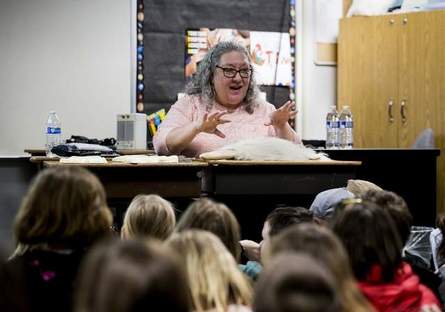
By DEVIN HEILMAN
Staff Writer, Coeur d'Alene Press
April 8, 2017
COEUR d’ALENE — Baby dinosaurs. Sasquatch. Albino squirrels.
Pretty much everything children's author Kelly Milner Halls presented to Fernan STEM Academy students on Friday was received with amazement, amusement and awe.
"I like how she likes wildness. I really like it, too," said second-grader Payson Shaw. "It really helps me think critical."
Critical thinking was at the core of Halls' critter-centric presentations, which were based on zoology, cryptozoology and mysteries of the natural and supernatural world. Her goal was to plant the seeds of curiosity that would sprout into hunger for knowledge and appetites for accuracy.
"When I do research, it's like playing a video game," she said to the second-graders. "Gamers are the most determined kids on the planet. They are also the best problem-solvers because you cannot beat a video game if you don't solve problems and you don't stick to it."
Halls is the author of more than 30 books, several nonfiction, that range in topic from animal rescue stories and wild horses to astronauts and science-fair projects. She has been a fan of unusual subjects since she was young and started her writing career studying journalism.
"When I was a kid I used to sit on my dad’s lap and watch weird documentaries. We’d watch Loch Ness monster and Bigfoot and space documentaries,” she said. "My dad was a very conservative Republican guy but he was accepting, he allowed me to develop whatever my interests were.
“He would say, ‘Let’s look at the evidence,’” she continued. “So I grew up hungry, making him insane, my mom insane asking 10 million questions, making my teachers crazy. Then I realized if I am a journalist, it’s my job to ask questions. It was the perfect place for me."
Halls then began writing for kids, giving her an avenue to share that craving for knowledge and love of the strange and unknown with young readers.
She brought a few visual aides to embellish her Fernan presentations, including alleged Bigfoot plaster prints and a white Sasquatch-like mask from the early days of "Star Trek." One lucky student, Parker Parisot, got to put the mask on for a moment and laugh along with her schoolmates.
“I loved her presentation," Parker said. “It felt really weird when I put on the mask."
Halls' author visit was made possible through the Meet the Author! Be An Author! grant Title I reading specialist Shelby Randklev received from the Excel Foundation. Halls is the third author to visit through this program.
"A lot of our students have never met a real author before, so this was to get them excited about reading and becoming a writer and becoming a thinker," Randklev said. "What I wanted with Kelly was nonfiction and just examining your evidence — what's real, what's not? — and to think critically about the things you read and the things you see and compare multiple views to come up with an educated opinion."
Toward the end of Hall's session with the second-graders, she reminded them they are capable of "digging deep" into whatever subjects they care about and maybe someday carrying on the torch as writers of the weird.
"Do I seem like a rocket scientist, or do I seem like a weird old grandma who likes to look up facts?" she asked the vocal crowd. "You understand that you can do this too? It's a great job. You have to do weird stuff. I had to dig up a T-Rex once. One time, I had to go swimming with the dolphins. One time I had to do indoor skydiving, and one time I had to pet baby polar bears. Think about doing my job.
"You are the next writers. What you care about is important."
Staff Writer, Coeur d'Alene Press
April 8, 2017
COEUR d’ALENE — Baby dinosaurs. Sasquatch. Albino squirrels.
Pretty much everything children's author Kelly Milner Halls presented to Fernan STEM Academy students on Friday was received with amazement, amusement and awe.
"I like how she likes wildness. I really like it, too," said second-grader Payson Shaw. "It really helps me think critical."
Critical thinking was at the core of Halls' critter-centric presentations, which were based on zoology, cryptozoology and mysteries of the natural and supernatural world. Her goal was to plant the seeds of curiosity that would sprout into hunger for knowledge and appetites for accuracy.
"When I do research, it's like playing a video game," she said to the second-graders. "Gamers are the most determined kids on the planet. They are also the best problem-solvers because you cannot beat a video game if you don't solve problems and you don't stick to it."
Halls is the author of more than 30 books, several nonfiction, that range in topic from animal rescue stories and wild horses to astronauts and science-fair projects. She has been a fan of unusual subjects since she was young and started her writing career studying journalism.
"When I was a kid I used to sit on my dad’s lap and watch weird documentaries. We’d watch Loch Ness monster and Bigfoot and space documentaries,” she said. "My dad was a very conservative Republican guy but he was accepting, he allowed me to develop whatever my interests were.
“He would say, ‘Let’s look at the evidence,’” she continued. “So I grew up hungry, making him insane, my mom insane asking 10 million questions, making my teachers crazy. Then I realized if I am a journalist, it’s my job to ask questions. It was the perfect place for me."
Halls then began writing for kids, giving her an avenue to share that craving for knowledge and love of the strange and unknown with young readers.
She brought a few visual aides to embellish her Fernan presentations, including alleged Bigfoot plaster prints and a white Sasquatch-like mask from the early days of "Star Trek." One lucky student, Parker Parisot, got to put the mask on for a moment and laugh along with her schoolmates.
“I loved her presentation," Parker said. “It felt really weird when I put on the mask."
Halls' author visit was made possible through the Meet the Author! Be An Author! grant Title I reading specialist Shelby Randklev received from the Excel Foundation. Halls is the third author to visit through this program.
"A lot of our students have never met a real author before, so this was to get them excited about reading and becoming a writer and becoming a thinker," Randklev said. "What I wanted with Kelly was nonfiction and just examining your evidence — what's real, what's not? — and to think critically about the things you read and the things you see and compare multiple views to come up with an educated opinion."
Toward the end of Hall's session with the second-graders, she reminded them they are capable of "digging deep" into whatever subjects they care about and maybe someday carrying on the torch as writers of the weird.
"Do I seem like a rocket scientist, or do I seem like a weird old grandma who likes to look up facts?" she asked the vocal crowd. "You understand that you can do this too? It's a great job. You have to do weird stuff. I had to dig up a T-Rex once. One time, I had to go swimming with the dolphins. One time I had to do indoor skydiving, and one time I had to pet baby polar bears. Think about doing my job.
"You are the next writers. What you care about is important."
Photos by Loren Benoit -- Second grader Leah Zahnow reacts to seeing an image of a baby dinosaur at Kelly Milner Halls presentation Friday afternoon at school.
october 2016 events "on the coast" -- Seattle/Port townsend
Read the full Camas article HERE.
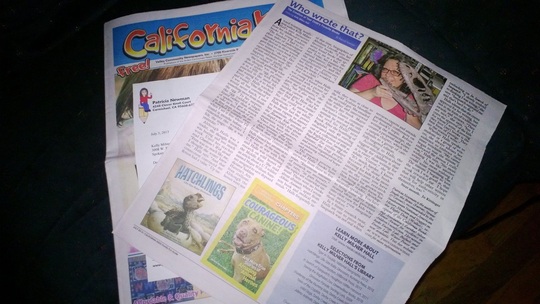
THANK YOU, PATRICIA NEWMAN!
For writing about me in print and on your website. Want to know more about the work I do? Patricia's work is a great place to start. Click HERE.
For writing about me in print and on your website. Want to know more about the work I do? Patricia's work is a great place to start. Click HERE.
Authorlinks Interview
by Susan VanHecke
Kelly Milner Halls was always the weird kid, "the kid who asked too many questions, the kid who couldn't stop talking to her neighbors, the kid who couldn't find a book she wanted to read," she confesses on her website, www.wondersofweird.com.
But when Halls discovered in high school that she could actually write, she channeled her inner weirdness to launch a children's writing career that now includes more than 1,500 articles for publications from Highlights for Children and Teen People to Writers Digest and the Washington Post, as well as a slew of award-winning children's books. Her touchstone topics? Anything weird, and the weirder, the better. Dinosaurs, cryptids, aliens, mummy children, wild dogs—they're all Halls' stock-in-trade and what make her offbeat books especially appealing to reluctant readers, her favorite audience.
Her latest volume, In Search of Sasquatch (Houghton Mifflin, 2011), introduces kids to cryptozoology's gentle giant and those folks devoted to proving the legendary creature's existence. Stunning to look at and fascinating to read, the book touches on scientific methods and encourages kids' critical thinking as they ponder the world's mysteries. As Kirkus enthused, In Search of Sasquatch "should give young cryptid hunters a good hairy leg up on investigations of their own."
“In Search of Sasquatch was an absolute joy to write and research.”
—HALLS
AUTHORLINK: Was this book as much fun to write as it is to read? You obviously have a passion for Bigfoot investigation—how did the book come about?
HALLS: In Search of Sasquatch was an absolute joy to write and research. Following Bigfoot hunters around is a real adventure. It's a quest full of thrills and chills and very hopeful expectations. Even when they didn't pan out, the attempts were worthwhile. After all, you're out there in the wilderness, breathing in the atmosphere and the promise of nature. How can that be bad? I did not find any solid evidence of Sasquatch on my very amateur investigations, but the promise of finding something is pretty darned exciting. I can see why the pros do what they do.
AUTHORLINK: I see that you conducted scads of interviews yourself. What other kinds of research did you do? How important to you was it to have the text vetted by an anthropologist in the field?
HALLS: To prepare for writing In Search of Sasquatch, I read almost a dozen adult nonfiction books—and one adult "nonfiction" book I suspect is pure fiction. I did a lot of fascinating interviews. I attended a Bigfoot conference, and I did a little very amateur fieldwork. I went out "squatching" with friends in Washington State to be sure I had an accurate sense of what the quest is all about, how it feels. I used to do a lot of backpacking in the High Sierras of California in my teens, so I had some outdoor history, but I wanted to be sure.
Even so, having [anthropologist and author] Kathy Strain standing by to vet the final manuscript was terribly important to me. I do my best as a journalist to represent things accurately—in this case the investigative work of serious people trying to find Sasquatch. But I'm not the expert. I depend on experts to double-check my work to be sure I didn't misunderstand anything important. Kathy was a huge asset, and I am beyond grateful for her time and notes. If the book is good, it's because of the generosity of experts like Kathy. My books are only as good as the people willing to help me.
AUTHORLINK: How have you managed to have the same illustrator, Rick Spears, work on at least four of your books, including Sasquatch, with four different publishers? That's quite a feat!
“Wait until you see THOSE alien and UFO illustrations. Love them.”
--HALLS
HALLS: I met Rick Spears when I was researching my first trade nonfiction book, Dino-Trekking (Wiley, 1995). He volunteered to illustrate that book for free, and free was exactly my budget. He works full-time for a natural science center and builds life-size, accurate dinosaur models in his spare time. He knows dinosaurs inside and out. When I wrote Dinosaur Mummies (Darby Creek, 2006) I asked my editor, Tanya Dean Anderson, if Rick could do the illustrations. She had already hired another illustrator, so the answer was no. Then the illustrator fell through at the last minute. Rick agreed to finish the job for half the pay in half the time, and did a fantastic job. So Tanya was sold. He did one illustration for Mysteries of the Mummy Kids (Darby Creek, 2007). Then I submitted my proposal for Tales of the Cryptids (Darby Creek, 2006) and asked Tanya if we could use Rick again. She remembered how great he was to work with on Dinosaur Mummies and almost immediately agreed. He nailed it, so when Houghton Mifflin Harcourt agreed to let me do Sasquatch, he seemed like the obvious choice. He also illustrated Alien Investigation, my next book for Millbrook. Wait until you see THOSE alien and UFO illustrations. Love them.
AUTHORLINK: When you sold Sasquatch to Houghton Mifflin, did you have a completed manuscript, or did you sell from proposal (one of the many fabulous things about writing nonfiction)? Did you have any idea what the finished product might look like, or was it all a glorious surprise? It's one beautiful book!
HALLS: I had a very detailed proposal ready when I approached Houghton Mifflin Harcourt with In Search of Sasquatch. I had hoped it would be a Scientist in the Field book, so I submitted to Erica Zappy, just as any other writer would submit—slush pile. Two or three months passed and I didn't hear back, so I figured the answer was no. Then I got a fantastic email from Erica Zappy asking if the book was still available, wondering how it had been overlooked for all those weeks. I said it was available, she took it to acquisitions, and they bought it. The science was not quite solid enough for it to be a Scientist in the Field book, but they thought it was a great standalone title, and I was delighted either way. Working with such a brilliant editor is a treat, however it unfolds, so I was delighted.
I did have to acquire all the photographs for the project, so on some level I could picture possible layouts. But I had no idea how utterly beautiful the finished book would be. Writers are only one element of a vibrant team of professionals who make a book possible. We give them raw materials, the illustrations we've commissioned, but editors and art directors really make the magic happen. They bring the book to life. Then the marketing and sales people step in to bring all that work to the public. Somehow, they make people care about THIS book, when there are hundreds out there competing for attention. This industry is a collaboration of hardworking pros, and I'm so lucky to be part of that team—every time I get to write a new book.
AUTHORLINK: You've written tons of award-winning nonfiction for young readers, starting with magazines early in your career. How did you make the leap from selling to magazines to selling to publishing houses? Have you found your career building momentum—does one book sale or great reviews or an award make the next pitch and sale a bit easier?
“For about ten years, I wrote magazine and newspaper nonfiction for young readers...”
—HALLS HALLS: For about ten years, I wrote magazine and newspaper nonfiction for young readers (or nonfiction about children's books and authors) almost exclusively. I was a single mom with two kids to care for, and I couldn't travel very often. Juggling twelve articles a month fed my family and kept a roof over our heads. But as my children got older, I began to yearn for something a little more lasting. I wanted to write books. I'd written a fictional picture book, two trade nonfiction books, and a couple of work-for-hire projects when Tanya Dean Anderson called me. She'd been my editor at Guideposts for Teens and was launching a brand new publishing house aimed at reaching reluctant readers, Darby Creek Publishing. She asked me if I had anything good, and I mentioned a dinosaur named Leonardo found with 70 percent of its soft tissue fossilized along with its bones. I wrote up a proposal, and Tanya bought it. For the first time, I was allowed to format my nonfiction books very much as I had my magazine articles, because we were trying to engage reluctant readers. In many ways, my nonfiction book career was born with Dinosaur Mummies. And I wrote five more books with Tanya at Darby Creek— each reflecting the writer I am, and the reluctant reader I once was. I'd found my voice and my purpose.
Success has made my reach broader—editors are more willing to look at my proposals, perhaps, because I have a track record. But the topics I pick SEEM risky. They sell really well—in part because I do fifty to seventy-five school visits a year to hand-sell them, in part because kids out there are hungry for the kinds of books I write. But I swim upstream in my approach in many ways, and that can be a tough sell at a marketing meeting. So I work hard on every proposal. I hope someday an editor will offer me a three-book deal so I'll have a little job security, but I'll do fine forging ahead one book at a time. I've done it a long time now.
AUTHORLINK: Does a nonfiction writer need an agent? Are agents even interested in children's nonfiction authors? Nonfiction hardly brings in the six figure advances. Is a nonfiction author her own best advocate?
“The minute I signed with Jill and the Herman Agency (September 11, 2010), I had people looking out for me...”
—HALLS HALLS: I only signed on with an agent a year ago—Jill Corcoran at the Herman Agency. I got agency owner Ronnie Herman in the deal, too, to my great and grateful surprise. They are both remarkable professionals who work REALLY hard for me. So, yes, having an agent is fantastic—like having a team on your advance team, the same way you have the publishing team in your court after the book is finished. But I did reasonably well on my own too. I had to. Sink or swim is a great motivator, and writing was all I knew how to do. If I didn't succeed, my kids would be homeless. But in the year I've had Jill and Ronnie, I've been enormously comforted by the fact that someone else was working to help me build editorial relationships.
Let's put it this way. In my youth, I was a pretty good shortstop because I loved the idea of covering two bases at once. I loved the challenge of doing what seemed impossible. I think I thrived without an agent for the same reason. But I also felt pretty isolated—alone. No one cared if I got a contract. No one cared if I won an award. No one sang my praises unless it was me...and I felt pretty weird blowing my own horn. The minute I signed with Jill and the Herman Agency (September 11, 2010), I had people looking out for me—people who cared about what I was trying to do as a writer. They believed in me, and it made it easier to believe in myself.
So, no, it's not mandatory to have an agent if you write nonfiction. It can be done, and I did it a lot of years on my own to some measure of success. But having Jill and Ronnie out there fighting for me is such a huge blessing. That said, not many agents WANT to represent nonfiction, so it's a good thing it's not essential, because I would have starved to death waiting.
AUTHORLINK: It's a challenging time for nonfiction authors, what with the instant information available on the Internet and all the new digitally-enhanced, multimedia apps and ebooks. Have you dipped your writerly toes into the digital seas yet? Do you see children's publishers embracing the new technologies or waiting to see how things shake out before moving forward?
HALLS: It is a challenging time for all writers, for all publishers, for all industries, truth be told. Everyone is cutting back. But I don't see the digital future as a bad thing, especially not for nonfiction. Nonfiction is especially well suited for digital applications because what we write about is real. I haven't seen my books adapted yet, but I'm excited at the notion. Imagine talking, for example, about the Patterson-Gimlin film, the famed 1967 footage that made Bigfoot famous. Now imagine reading Tales of the Cryptids or In Search of Sasquatch in a digital application, then clicking on that still frame from the film to reveal the full 1:06-minute experience right there on your iPad. I think that's a remarkable concept sure to draw my reluctant readers further into their nonfiction explorations. So I'm excited by the possibilities. I do think the royalties may need a little closer examination to be fair to the writers and the publishers gambling on the success of the books. But I have faith that'll all be decided fairly once the technologies are readily available. I can't wait for the day when my books are in traditional print AND in digital formats. I think both will survive, when the dust has cleared.
AUTHORLINK: You have a few other titles out now or soon forthcoming. Can you talk a bit about Alien Investigation, Hatchlings, and the anthology Girl Meets Boy and how they came about?
“I LOVE this book. I'm so excited about it, I can't wait for it to be released.”
—HALLS HALLS: Alien Investigation is the official follow-up to Tales of the Cryptids. It begins with fictional "What if..." moments, as Cryptids does, followed by chapters of carefully researched nonfiction evidence for and against UFOs and alien encounters. I LOVE this book. I'm so excited about it, I can't wait for it to be released. Kids have been asking me to write this book for years, and I'm excited to deliver it. Kids have been asking for a book about ghosts, too, so that won't be too far behind Aliens, which will be for sale as of January 15, 2012. I get my author copies next month.
Hatchlings: Life-Size Baby Dinosaurs is exactly what it seems to be. It's one of only three books I've ever written for very young readers, ages four to seven. Researching another dinosaur project, I discovered that baby dinosaurs were almost always relatively small when they first hatched from their eggs—small enough to fit on the page of a slightly oversized picture book. I thought, "Man, my smaller readers would love to see how little those giants once were." Editor Lisa Cheng at Running Press (Perseus Books) agreed, and it'll be out in April of 2012. I love the illustrations Adam Relf came up with—very compelling, realistic two-page spreads, even though the book is for very young readers. I love the respect that conveys. Those little readers are small, but important. Hatchlings is just for them.
Girl Meets Boy (Chronicle, 2011) is a young adult anthology for mature teen readers—and quite a departure for me. I've been good friends with a group of talented YA authors for many years now, and a HUGE fan of YA literature as a reader myself. I came up with the idea of an anthology that would explore how two people can see the same event very differently. So I gathered pairs of prominent YA authors willing to explore those differences. One writer wrote a story about an event from a male or female point of view. His or her partner told the same story from the opposite gender's point of view. The result turned out to be something really special, thanks in large part to the stellar talent of the writers who agreed to participate—James Howe and Ellen Wittlinger, Sara Ryan and Randy Powell, Terry Trueman and Rita Williams-Garcia, Cynthia Leitich-Smith and Joseph Bruchac, Terry Davis and Rebecca Davis, Chris Crutcher and me. I am, by far, the weakest link in the chain, in that this is my first attempt at YA fiction. But with a mentor like Chris Crutcher, how could I lose? It's a daring collection of stories, sure to be challenged—not for my traditional readers ages nine to twelve. But I hope it touches YA readers looking for stories they can sink their teeth in. Nothing would please me more.
AUTHORLINK: For many years you've worked as Chris Crutcher's assistant. How did you get that cool gig? And what, exactly, do you do for him? How has your work with him affected your own writing?
“Working for Chris has taught me so much.”
—HALLS HALLS: Fifteen years ago, I "met" Chris via a telephone interview. I was the executive editor at KidsReads.com, part of the Book Reporter Network. At the time, KidsReads included YA literature, though it later broke off as TeenReads.com. It was my job to write ten book reviews a week AND four special features—two themed book round-ups and two author interviews. My daughter was fourteen and hated to read because her life had been tougher than most teens. The books she was asked to read didn't move her. I was on the lookout for powerful YA writers when I stumbled upon Chris Crutcher's Staying Fat for Sarah Byrnes (Greenwillow, 2003). I knew this was what Kerry had been looking for, and I knew I had to write about the guy who understood kids like mine.
We talked for two hours that day, and a professional friendship was born. Several years later, I wrote another piece about him for the Denver Post, then another for our local newspaper, the Spokesman Review. He could never find a current author photo for the editors, and I kept teasing him, telling him he should hire an assistant to keep track of things like that for him. A year or so later, he was going out of town and asked me to organize his files while he was gone. I found an invitation to China in the stacks, a trip just two months away, so I asked him if I could follow up on the trip. He said he was sure everything was set, but sure, I could check it out.
I wrote to the contact and asked if they needed anything to prepare for Chris Crutcher's visit; they said they had never heard back from Chris and so had invited another author visitor. When he got back into town, I told him what I'd discovered, and said, "Chris, you REALLY need an assistant to keep track of this stuff."
"Okay," he said, "but only if you'll do it." I never meant ME when I made the suggestion, but how could I refuse? That was ten years ago, and I've been his assistant ever since.
I keep his professional calendar and coordinate all of his author visits and conference appearances. He gets a request, the request goes to me, and my work begins. Once his hosts and I get all the groundwork completed, he flies out and does the hard part. But I get to help some amazing people bring a talented author to their schools or events with confidence. I make sure they have all the support materials they need, I prepare travel briefings for Chris for each trip, I coordinate press coverage, I handle his website, and, when his girlfriend is busy, I sometimes feed his cats. I also get to help with all the book challenges that are filed against his books—free speech—one of my favorite parts of working for Chris, as a journalist. It's a wonderful job, and I love it—almost as much as I love writing my own books.
Working for Chris has taught me so much. For example, my presentations for schools and conferences are really strong in part because I learned how to do them watching Chris. We write very different things, but the connection to our readers is identical. He told me once, "The people who come to hear you speak don't just want to hear about the books. They want to hear about who you are and why you write them. They want to see where the books come from; they want a glimpse of who you are. That connection is what really matters."
That advice transformed my whole approach to sharing the work I do. And I'm so grateful for it.
He's also mentored me as a fiction writer for several years. My story—a response to his story in Girl Meets Boy—is my first published YA effort, but I am working on my first YA novel, and he's agreed to work with me to make it the best it can be. Believe me, I know how fortunate I am. I won't squander that opportunity.
AUTHORLINK: What are you working on now?
“I'll do my best to keep writing books kids can't wait to dig into.”
—HALLS HALLS: Other than the YA novel, I'm working on a new YA anthology for Chronicle Books, an animal rescue book for kids ages seven to nine for National Geographic, plus a nonfiction history of video games called Game On, a nonfiction book about a baby elephant impacted by war, and a young reader history of tattoos—all for kids nine and up. There are other projects in the works, but I've got to save something for the next interview. One thing is certain, I'll do my best to keep writing books kids can't wait to dig into. Those topics are the topics that most appeal to me, too. I can't ever see that changing.
About Susan VanHecke
Susan VanHecke is an author and editor of books for adults and children. Her titles for young people include Raggin' Jazzin' Rockin': A History of American Musical Instrument Makers (Boyds Mills, 2011), Rock 'N' Roll Soldier (HarperCollins, 2009), and An Apple Pie For Dinner (Cavendish, 2009). To find out more about Susan and her books, visit www.susanvanhecke.com and www.susanvanheckeeditorial.com.
Kelly Milner Halls was always the weird kid, "the kid who asked too many questions, the kid who couldn't stop talking to her neighbors, the kid who couldn't find a book she wanted to read," she confesses on her website, www.wondersofweird.com.
But when Halls discovered in high school that she could actually write, she channeled her inner weirdness to launch a children's writing career that now includes more than 1,500 articles for publications from Highlights for Children and Teen People to Writers Digest and the Washington Post, as well as a slew of award-winning children's books. Her touchstone topics? Anything weird, and the weirder, the better. Dinosaurs, cryptids, aliens, mummy children, wild dogs—they're all Halls' stock-in-trade and what make her offbeat books especially appealing to reluctant readers, her favorite audience.
Her latest volume, In Search of Sasquatch (Houghton Mifflin, 2011), introduces kids to cryptozoology's gentle giant and those folks devoted to proving the legendary creature's existence. Stunning to look at and fascinating to read, the book touches on scientific methods and encourages kids' critical thinking as they ponder the world's mysteries. As Kirkus enthused, In Search of Sasquatch "should give young cryptid hunters a good hairy leg up on investigations of their own."
“In Search of Sasquatch was an absolute joy to write and research.”
—HALLS
AUTHORLINK: Was this book as much fun to write as it is to read? You obviously have a passion for Bigfoot investigation—how did the book come about?
HALLS: In Search of Sasquatch was an absolute joy to write and research. Following Bigfoot hunters around is a real adventure. It's a quest full of thrills and chills and very hopeful expectations. Even when they didn't pan out, the attempts were worthwhile. After all, you're out there in the wilderness, breathing in the atmosphere and the promise of nature. How can that be bad? I did not find any solid evidence of Sasquatch on my very amateur investigations, but the promise of finding something is pretty darned exciting. I can see why the pros do what they do.
AUTHORLINK: I see that you conducted scads of interviews yourself. What other kinds of research did you do? How important to you was it to have the text vetted by an anthropologist in the field?
HALLS: To prepare for writing In Search of Sasquatch, I read almost a dozen adult nonfiction books—and one adult "nonfiction" book I suspect is pure fiction. I did a lot of fascinating interviews. I attended a Bigfoot conference, and I did a little very amateur fieldwork. I went out "squatching" with friends in Washington State to be sure I had an accurate sense of what the quest is all about, how it feels. I used to do a lot of backpacking in the High Sierras of California in my teens, so I had some outdoor history, but I wanted to be sure.
Even so, having [anthropologist and author] Kathy Strain standing by to vet the final manuscript was terribly important to me. I do my best as a journalist to represent things accurately—in this case the investigative work of serious people trying to find Sasquatch. But I'm not the expert. I depend on experts to double-check my work to be sure I didn't misunderstand anything important. Kathy was a huge asset, and I am beyond grateful for her time and notes. If the book is good, it's because of the generosity of experts like Kathy. My books are only as good as the people willing to help me.
AUTHORLINK: How have you managed to have the same illustrator, Rick Spears, work on at least four of your books, including Sasquatch, with four different publishers? That's quite a feat!
“Wait until you see THOSE alien and UFO illustrations. Love them.”
--HALLS
HALLS: I met Rick Spears when I was researching my first trade nonfiction book, Dino-Trekking (Wiley, 1995). He volunteered to illustrate that book for free, and free was exactly my budget. He works full-time for a natural science center and builds life-size, accurate dinosaur models in his spare time. He knows dinosaurs inside and out. When I wrote Dinosaur Mummies (Darby Creek, 2006) I asked my editor, Tanya Dean Anderson, if Rick could do the illustrations. She had already hired another illustrator, so the answer was no. Then the illustrator fell through at the last minute. Rick agreed to finish the job for half the pay in half the time, and did a fantastic job. So Tanya was sold. He did one illustration for Mysteries of the Mummy Kids (Darby Creek, 2007). Then I submitted my proposal for Tales of the Cryptids (Darby Creek, 2006) and asked Tanya if we could use Rick again. She remembered how great he was to work with on Dinosaur Mummies and almost immediately agreed. He nailed it, so when Houghton Mifflin Harcourt agreed to let me do Sasquatch, he seemed like the obvious choice. He also illustrated Alien Investigation, my next book for Millbrook. Wait until you see THOSE alien and UFO illustrations. Love them.
AUTHORLINK: When you sold Sasquatch to Houghton Mifflin, did you have a completed manuscript, or did you sell from proposal (one of the many fabulous things about writing nonfiction)? Did you have any idea what the finished product might look like, or was it all a glorious surprise? It's one beautiful book!
HALLS: I had a very detailed proposal ready when I approached Houghton Mifflin Harcourt with In Search of Sasquatch. I had hoped it would be a Scientist in the Field book, so I submitted to Erica Zappy, just as any other writer would submit—slush pile. Two or three months passed and I didn't hear back, so I figured the answer was no. Then I got a fantastic email from Erica Zappy asking if the book was still available, wondering how it had been overlooked for all those weeks. I said it was available, she took it to acquisitions, and they bought it. The science was not quite solid enough for it to be a Scientist in the Field book, but they thought it was a great standalone title, and I was delighted either way. Working with such a brilliant editor is a treat, however it unfolds, so I was delighted.
I did have to acquire all the photographs for the project, so on some level I could picture possible layouts. But I had no idea how utterly beautiful the finished book would be. Writers are only one element of a vibrant team of professionals who make a book possible. We give them raw materials, the illustrations we've commissioned, but editors and art directors really make the magic happen. They bring the book to life. Then the marketing and sales people step in to bring all that work to the public. Somehow, they make people care about THIS book, when there are hundreds out there competing for attention. This industry is a collaboration of hardworking pros, and I'm so lucky to be part of that team—every time I get to write a new book.
AUTHORLINK: You've written tons of award-winning nonfiction for young readers, starting with magazines early in your career. How did you make the leap from selling to magazines to selling to publishing houses? Have you found your career building momentum—does one book sale or great reviews or an award make the next pitch and sale a bit easier?
“For about ten years, I wrote magazine and newspaper nonfiction for young readers...”
—HALLS HALLS: For about ten years, I wrote magazine and newspaper nonfiction for young readers (or nonfiction about children's books and authors) almost exclusively. I was a single mom with two kids to care for, and I couldn't travel very often. Juggling twelve articles a month fed my family and kept a roof over our heads. But as my children got older, I began to yearn for something a little more lasting. I wanted to write books. I'd written a fictional picture book, two trade nonfiction books, and a couple of work-for-hire projects when Tanya Dean Anderson called me. She'd been my editor at Guideposts for Teens and was launching a brand new publishing house aimed at reaching reluctant readers, Darby Creek Publishing. She asked me if I had anything good, and I mentioned a dinosaur named Leonardo found with 70 percent of its soft tissue fossilized along with its bones. I wrote up a proposal, and Tanya bought it. For the first time, I was allowed to format my nonfiction books very much as I had my magazine articles, because we were trying to engage reluctant readers. In many ways, my nonfiction book career was born with Dinosaur Mummies. And I wrote five more books with Tanya at Darby Creek— each reflecting the writer I am, and the reluctant reader I once was. I'd found my voice and my purpose.
Success has made my reach broader—editors are more willing to look at my proposals, perhaps, because I have a track record. But the topics I pick SEEM risky. They sell really well—in part because I do fifty to seventy-five school visits a year to hand-sell them, in part because kids out there are hungry for the kinds of books I write. But I swim upstream in my approach in many ways, and that can be a tough sell at a marketing meeting. So I work hard on every proposal. I hope someday an editor will offer me a three-book deal so I'll have a little job security, but I'll do fine forging ahead one book at a time. I've done it a long time now.
AUTHORLINK: Does a nonfiction writer need an agent? Are agents even interested in children's nonfiction authors? Nonfiction hardly brings in the six figure advances. Is a nonfiction author her own best advocate?
“The minute I signed with Jill and the Herman Agency (September 11, 2010), I had people looking out for me...”
—HALLS HALLS: I only signed on with an agent a year ago—Jill Corcoran at the Herman Agency. I got agency owner Ronnie Herman in the deal, too, to my great and grateful surprise. They are both remarkable professionals who work REALLY hard for me. So, yes, having an agent is fantastic—like having a team on your advance team, the same way you have the publishing team in your court after the book is finished. But I did reasonably well on my own too. I had to. Sink or swim is a great motivator, and writing was all I knew how to do. If I didn't succeed, my kids would be homeless. But in the year I've had Jill and Ronnie, I've been enormously comforted by the fact that someone else was working to help me build editorial relationships.
Let's put it this way. In my youth, I was a pretty good shortstop because I loved the idea of covering two bases at once. I loved the challenge of doing what seemed impossible. I think I thrived without an agent for the same reason. But I also felt pretty isolated—alone. No one cared if I got a contract. No one cared if I won an award. No one sang my praises unless it was me...and I felt pretty weird blowing my own horn. The minute I signed with Jill and the Herman Agency (September 11, 2010), I had people looking out for me—people who cared about what I was trying to do as a writer. They believed in me, and it made it easier to believe in myself.
So, no, it's not mandatory to have an agent if you write nonfiction. It can be done, and I did it a lot of years on my own to some measure of success. But having Jill and Ronnie out there fighting for me is such a huge blessing. That said, not many agents WANT to represent nonfiction, so it's a good thing it's not essential, because I would have starved to death waiting.
AUTHORLINK: It's a challenging time for nonfiction authors, what with the instant information available on the Internet and all the new digitally-enhanced, multimedia apps and ebooks. Have you dipped your writerly toes into the digital seas yet? Do you see children's publishers embracing the new technologies or waiting to see how things shake out before moving forward?
HALLS: It is a challenging time for all writers, for all publishers, for all industries, truth be told. Everyone is cutting back. But I don't see the digital future as a bad thing, especially not for nonfiction. Nonfiction is especially well suited for digital applications because what we write about is real. I haven't seen my books adapted yet, but I'm excited at the notion. Imagine talking, for example, about the Patterson-Gimlin film, the famed 1967 footage that made Bigfoot famous. Now imagine reading Tales of the Cryptids or In Search of Sasquatch in a digital application, then clicking on that still frame from the film to reveal the full 1:06-minute experience right there on your iPad. I think that's a remarkable concept sure to draw my reluctant readers further into their nonfiction explorations. So I'm excited by the possibilities. I do think the royalties may need a little closer examination to be fair to the writers and the publishers gambling on the success of the books. But I have faith that'll all be decided fairly once the technologies are readily available. I can't wait for the day when my books are in traditional print AND in digital formats. I think both will survive, when the dust has cleared.
AUTHORLINK: You have a few other titles out now or soon forthcoming. Can you talk a bit about Alien Investigation, Hatchlings, and the anthology Girl Meets Boy and how they came about?
“I LOVE this book. I'm so excited about it, I can't wait for it to be released.”
—HALLS HALLS: Alien Investigation is the official follow-up to Tales of the Cryptids. It begins with fictional "What if..." moments, as Cryptids does, followed by chapters of carefully researched nonfiction evidence for and against UFOs and alien encounters. I LOVE this book. I'm so excited about it, I can't wait for it to be released. Kids have been asking me to write this book for years, and I'm excited to deliver it. Kids have been asking for a book about ghosts, too, so that won't be too far behind Aliens, which will be for sale as of January 15, 2012. I get my author copies next month.
Hatchlings: Life-Size Baby Dinosaurs is exactly what it seems to be. It's one of only three books I've ever written for very young readers, ages four to seven. Researching another dinosaur project, I discovered that baby dinosaurs were almost always relatively small when they first hatched from their eggs—small enough to fit on the page of a slightly oversized picture book. I thought, "Man, my smaller readers would love to see how little those giants once were." Editor Lisa Cheng at Running Press (Perseus Books) agreed, and it'll be out in April of 2012. I love the illustrations Adam Relf came up with—very compelling, realistic two-page spreads, even though the book is for very young readers. I love the respect that conveys. Those little readers are small, but important. Hatchlings is just for them.
Girl Meets Boy (Chronicle, 2011) is a young adult anthology for mature teen readers—and quite a departure for me. I've been good friends with a group of talented YA authors for many years now, and a HUGE fan of YA literature as a reader myself. I came up with the idea of an anthology that would explore how two people can see the same event very differently. So I gathered pairs of prominent YA authors willing to explore those differences. One writer wrote a story about an event from a male or female point of view. His or her partner told the same story from the opposite gender's point of view. The result turned out to be something really special, thanks in large part to the stellar talent of the writers who agreed to participate—James Howe and Ellen Wittlinger, Sara Ryan and Randy Powell, Terry Trueman and Rita Williams-Garcia, Cynthia Leitich-Smith and Joseph Bruchac, Terry Davis and Rebecca Davis, Chris Crutcher and me. I am, by far, the weakest link in the chain, in that this is my first attempt at YA fiction. But with a mentor like Chris Crutcher, how could I lose? It's a daring collection of stories, sure to be challenged—not for my traditional readers ages nine to twelve. But I hope it touches YA readers looking for stories they can sink their teeth in. Nothing would please me more.
AUTHORLINK: For many years you've worked as Chris Crutcher's assistant. How did you get that cool gig? And what, exactly, do you do for him? How has your work with him affected your own writing?
“Working for Chris has taught me so much.”
—HALLS HALLS: Fifteen years ago, I "met" Chris via a telephone interview. I was the executive editor at KidsReads.com, part of the Book Reporter Network. At the time, KidsReads included YA literature, though it later broke off as TeenReads.com. It was my job to write ten book reviews a week AND four special features—two themed book round-ups and two author interviews. My daughter was fourteen and hated to read because her life had been tougher than most teens. The books she was asked to read didn't move her. I was on the lookout for powerful YA writers when I stumbled upon Chris Crutcher's Staying Fat for Sarah Byrnes (Greenwillow, 2003). I knew this was what Kerry had been looking for, and I knew I had to write about the guy who understood kids like mine.
We talked for two hours that day, and a professional friendship was born. Several years later, I wrote another piece about him for the Denver Post, then another for our local newspaper, the Spokesman Review. He could never find a current author photo for the editors, and I kept teasing him, telling him he should hire an assistant to keep track of things like that for him. A year or so later, he was going out of town and asked me to organize his files while he was gone. I found an invitation to China in the stacks, a trip just two months away, so I asked him if I could follow up on the trip. He said he was sure everything was set, but sure, I could check it out.
I wrote to the contact and asked if they needed anything to prepare for Chris Crutcher's visit; they said they had never heard back from Chris and so had invited another author visitor. When he got back into town, I told him what I'd discovered, and said, "Chris, you REALLY need an assistant to keep track of this stuff."
"Okay," he said, "but only if you'll do it." I never meant ME when I made the suggestion, but how could I refuse? That was ten years ago, and I've been his assistant ever since.
I keep his professional calendar and coordinate all of his author visits and conference appearances. He gets a request, the request goes to me, and my work begins. Once his hosts and I get all the groundwork completed, he flies out and does the hard part. But I get to help some amazing people bring a talented author to their schools or events with confidence. I make sure they have all the support materials they need, I prepare travel briefings for Chris for each trip, I coordinate press coverage, I handle his website, and, when his girlfriend is busy, I sometimes feed his cats. I also get to help with all the book challenges that are filed against his books—free speech—one of my favorite parts of working for Chris, as a journalist. It's a wonderful job, and I love it—almost as much as I love writing my own books.
Working for Chris has taught me so much. For example, my presentations for schools and conferences are really strong in part because I learned how to do them watching Chris. We write very different things, but the connection to our readers is identical. He told me once, "The people who come to hear you speak don't just want to hear about the books. They want to hear about who you are and why you write them. They want to see where the books come from; they want a glimpse of who you are. That connection is what really matters."
That advice transformed my whole approach to sharing the work I do. And I'm so grateful for it.
He's also mentored me as a fiction writer for several years. My story—a response to his story in Girl Meets Boy—is my first published YA effort, but I am working on my first YA novel, and he's agreed to work with me to make it the best it can be. Believe me, I know how fortunate I am. I won't squander that opportunity.
AUTHORLINK: What are you working on now?
“I'll do my best to keep writing books kids can't wait to dig into.”
—HALLS HALLS: Other than the YA novel, I'm working on a new YA anthology for Chronicle Books, an animal rescue book for kids ages seven to nine for National Geographic, plus a nonfiction history of video games called Game On, a nonfiction book about a baby elephant impacted by war, and a young reader history of tattoos—all for kids nine and up. There are other projects in the works, but I've got to save something for the next interview. One thing is certain, I'll do my best to keep writing books kids can't wait to dig into. Those topics are the topics that most appeal to me, too. I can't ever see that changing.
About Susan VanHecke
Susan VanHecke is an author and editor of books for adults and children. Her titles for young people include Raggin' Jazzin' Rockin': A History of American Musical Instrument Makers (Boyds Mills, 2011), Rock 'N' Roll Soldier (HarperCollins, 2009), and An Apple Pie For Dinner (Cavendish, 2009). To find out more about Susan and her books, visit www.susanvanhecke.com and www.susanvanheckeeditorial.com.
Books features about kmh
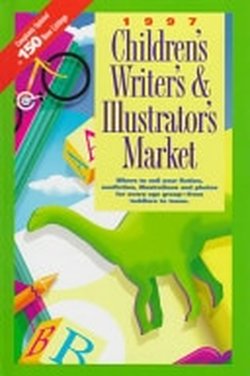
Children's Writer's & Illustrator's Market, 1997
Alice P. Buening, Editor
F & W Publications Incorporated, Jan 1, 1997
Feature profiling KMH's career as a magazine and newspaper freelance writer.
Alice P. Buening, Editor
F & W Publications Incorporated, Jan 1, 1997
Feature profiling KMH's career as a magazine and newspaper freelance writer.
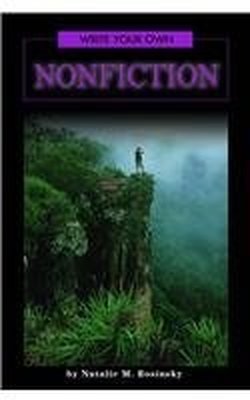
Write Your Own Nonfiction
by Natalie M. Rosinsky, 2009
Do you often pose the questions Why? or How? or What s next? If you want to find out the answers, you will enjoy writing nonfiction. This book will help you present intriguing facts with your own personal flair."
Features work by KMH.
by Natalie M. Rosinsky, 2009
Do you often pose the questions Why? or How? or What s next? If you want to find out the answers, you will enjoy writing nonfiction. This book will help you present intriguing facts with your own personal flair."
Features work by KMH.

